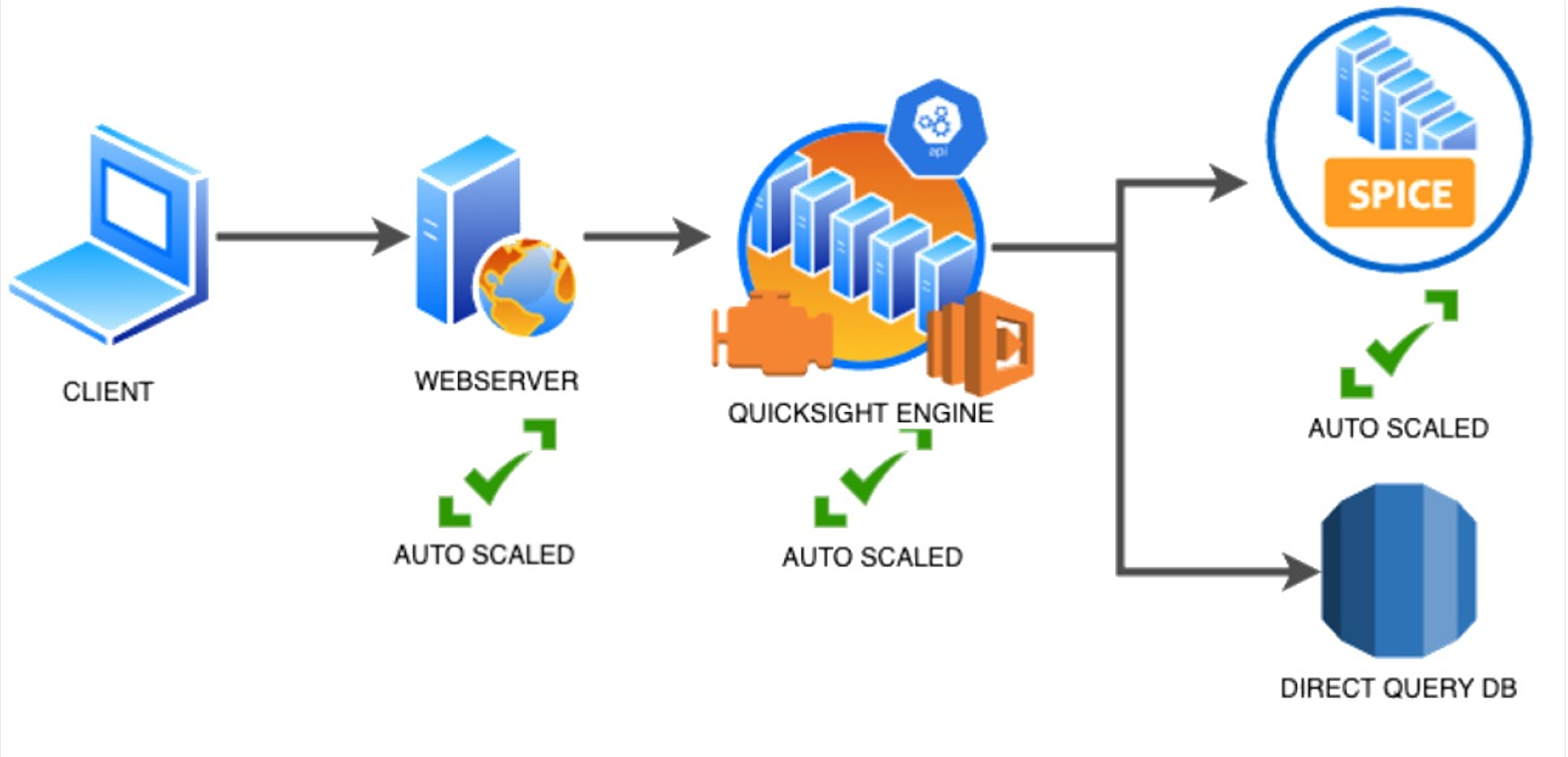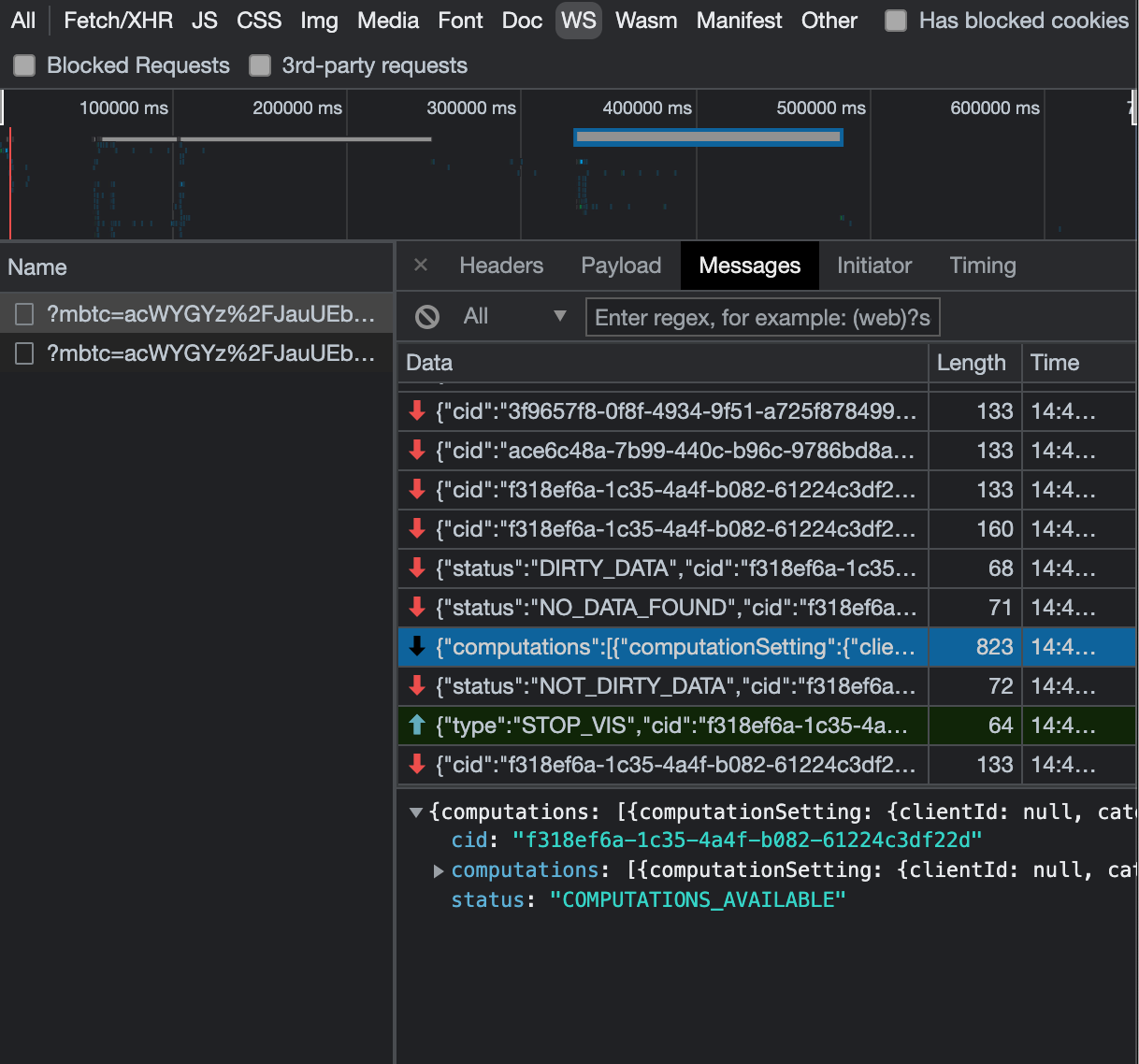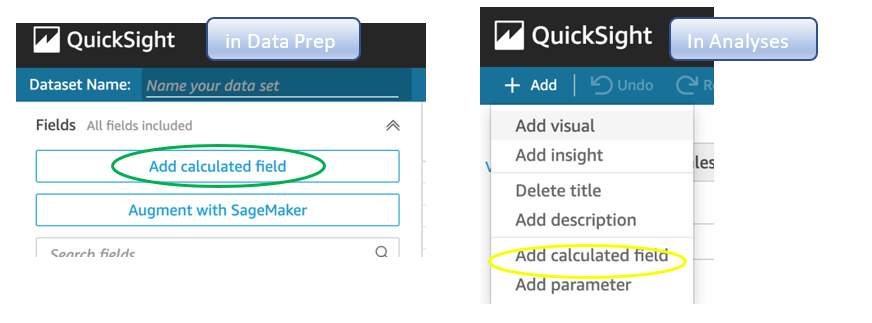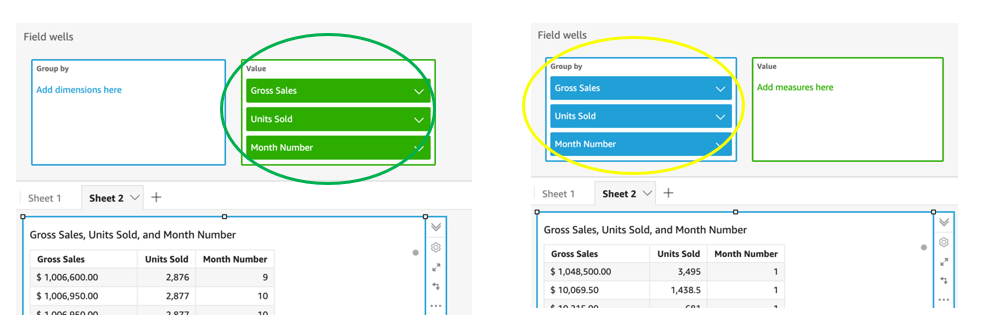Post Syndicated from Crosstalk Solutions original https://www.youtube.com/watch?v=UBtPme0RQ2U
Better Backup Practices: What Is the Grandfather-Father-Son Approach?
Post Syndicated from Kari Rivas original https://www.backblaze.com/blog/better-backup-practices-what-is-the-grandfather-father-son-approach/
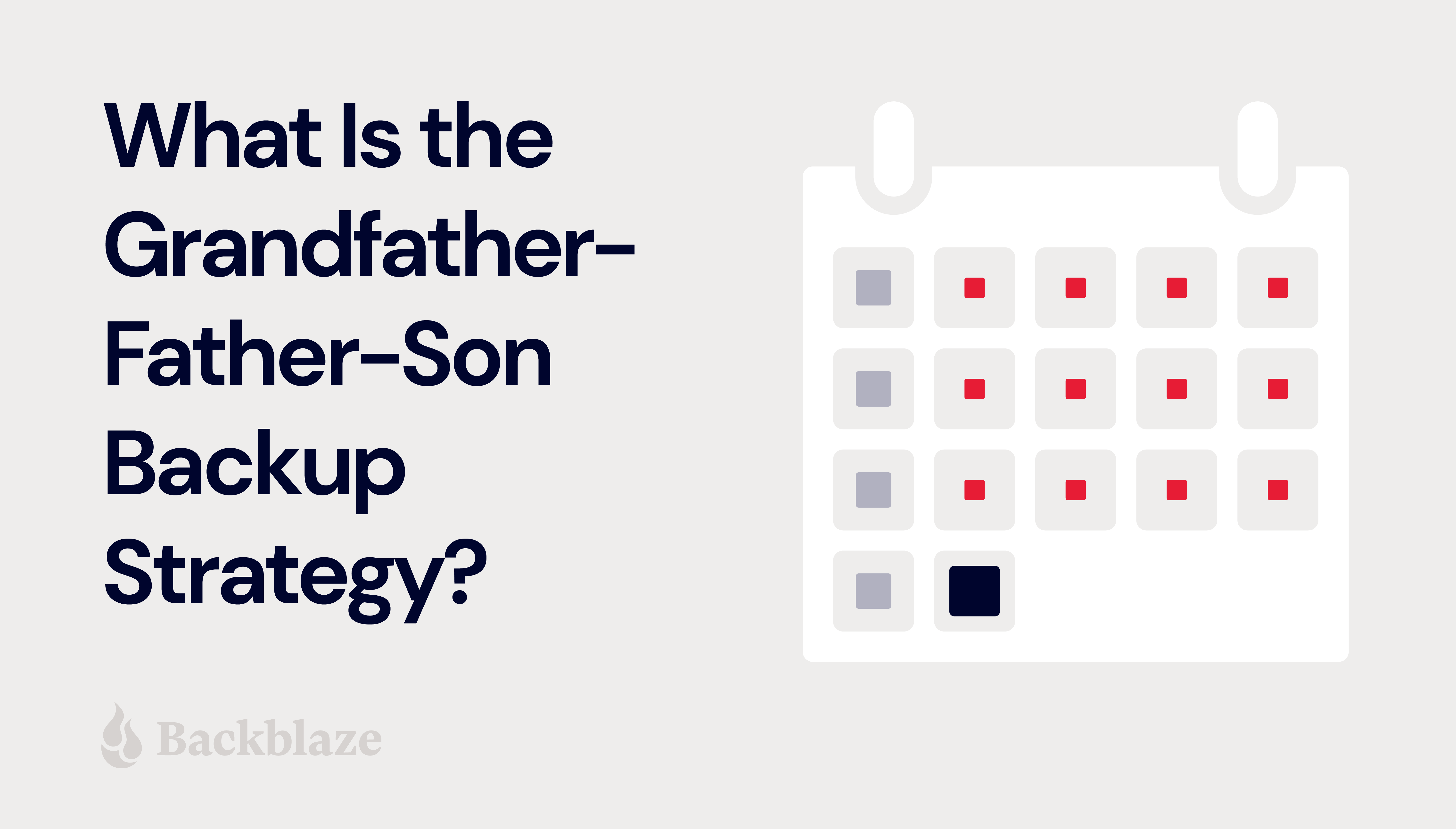
They say the older you get, the more you become your parents. It’s so true, Progressive Insurance built an entire marketing campaign around it. (Forcing food on your family? Guilty.) But when it comes to backups, generational copies are a good thing. In fact, there’s a widely-used backup approach based on the idea—grandfather-father-son (GFS) backups.
In this post, we’ll explain what GFS is and how GFS works, we’ll share an example GFS backup plan, and we’ll show you how you can use GFS to organize your backup approach.
What Are Grandfather-Father-Son Backups?
Whether you’re setting up your first cloud backup or researching how to enhance your data security practices, chances are you’ve already got the basics figured out, like using at least a 3-2-1 backup strategy, if not a 3-2-1-1-0 or a 4-3-2. You’ve realized you need at least three total copies of your data, two of which are local but on different media, and one copy stored off-site. The next part of your strategy is to consider how often to perform full backups, with the assumption that you’ll fill the gap between full backups with incremental (or differential) backups.
One way to simplify your decision-making around backup strategy, including when to perform full vs. incremental backups, is to follow the GFS backup scheme. GFS provides recommended, but flexible, rotation cycles for full and incremental backups and has the added benefit of providing layers of data protection in a manageable framework.
Refresher: Full vs. Incremental vs. Differential vs. Synthetic Backups
There are four different types of backups: full, incremental, synthetic full, and differential. And choosing the right mix of types helps you maximize efficiency versus simply performing full backups all the time and monopolizing bandwidth and storage space. Here’s a quick refresher on each type:
- Full backups: A complete copy of your data.
- Incremental backups: A copy of data that has changed or has been added since your last full backup or since the last incremental backup.
- Synthetic full backups: A synthesized “full” backup copy created from the full backup you have stored in the cloud plus your subsequent incremental backups. Synthetic full backups are much faster than full backups.
- Differential backups: A specialized type of backups popular for database applications like Microsoft SQL but not used frequently otherwise. Differential backups copy all changes since the last full backup every time (versus incrementals which only contain changes or additions since the last incremental). As you make changes to your data set, your differential backup grows.
Check out our complete guide on the difference between full, incremental, synthetic full, and differential backups here.
How Do GFS Backups Work?
In the traditional GFS approach, a full backup is completed on the same day of each month (for example, the last day of each month or the fourth Friday of each month—however you want to define it). This is the “grandfather” cycle. It’s best practice to store this backup off-site or in the cloud. This also helps satisfy the off-site requirement of a 3-2-1 strategy.
Next, another full backup is set to run on a more frequent basis, like weekly. Again, you can define when exactly this full backup should take place, keeping in mind your business’s bandwidth requirements. (Because full backups will most definitely tie up your network for a while!) This is the “father” cycle, and, ideally, your backup should be stored locally and/or in hot cloud storage, like Backblaze B2 Cloud Storage, where it can be quickly and easily accessed if needed.
Last, plan to cover your bases with daily incremental backups. These are the “son” backups, and they should be stored in the same location as your “father” backups.
GFS Backups: An Example
In the example month shown below, the grandfather backup is completed on the last day of each month. Father full backups run every Sunday, and incremental son backups run Monday through Saturday.
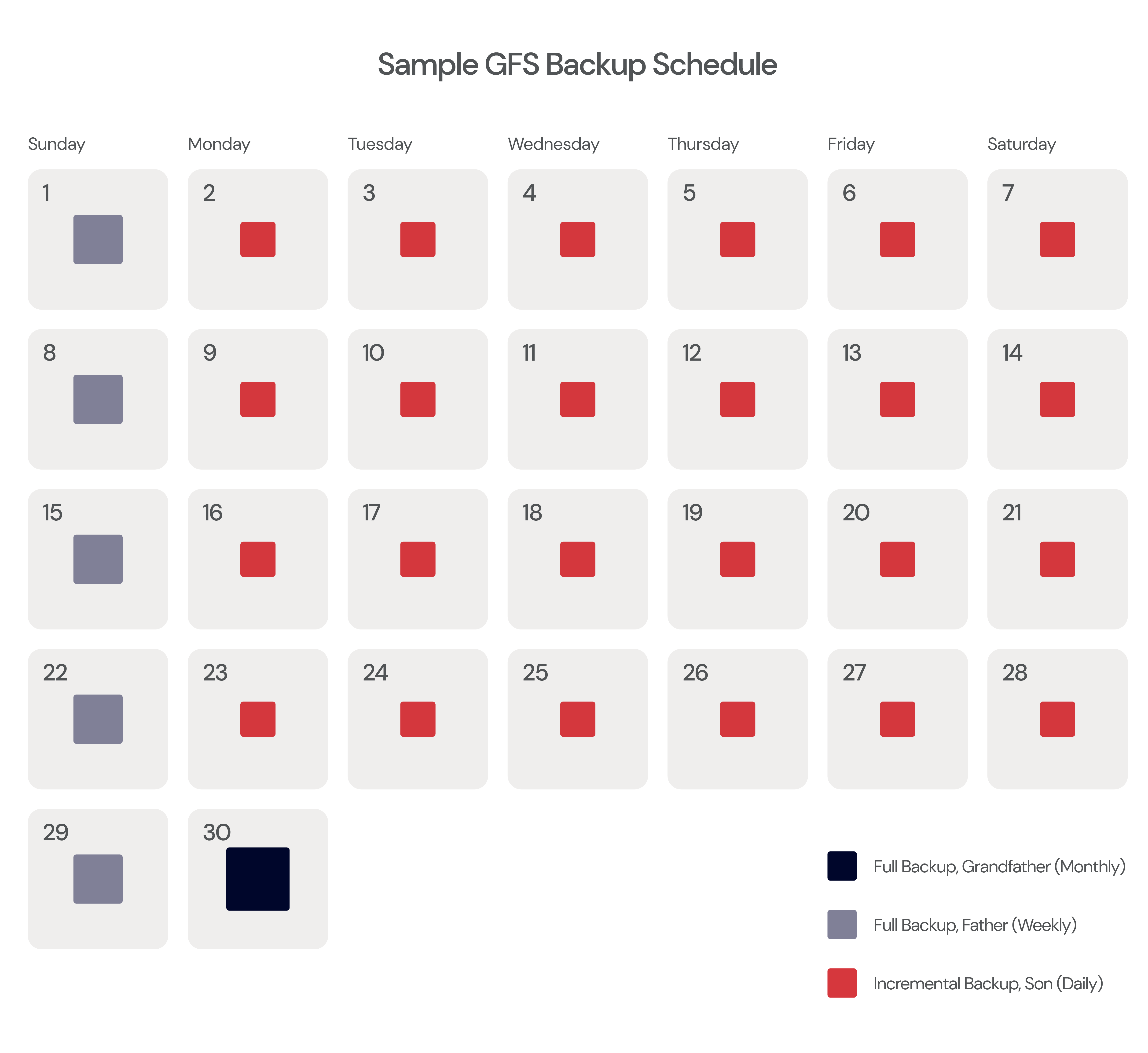
It’s important to note that the daily-weekly-monthly cadence is a common approach, but you could perform your incremental son backups even more often than daily (Like hourly!) or you could set your grandfather backups to run yearly instead of monthly. Some choose to run grandfather backups monthly and “great-grandfather” backups yearly. Essentially, you just want to create three regular backup cycles (one full backup to off-site storage; one full backup to local or hot storage; and incremental backups to fill the gaps) with your grandfather full backup cycle being performed less often than your father full backup cycle.
How Long Should You Retain GFS Backups?
Last, it’s important to also consider your retention policy for each backup cycle. In other words, how long do you want to keep your monthly grandfather backups, in case you need to restore data from one? How long do you want to keep your father and son backups? Are you in an industry that has strict data retention requirements?
You’ll want to think about how to balance regulatory requirements with storage costs. By the way, you might find us a little biased towards Backblaze B2 Cloud Storage because, at $5/TB/month, you can afford to keep your backups in quickly accessible hot storage and keep them archived for as long as you need without worrying about an excessive cloud storage bill.
Ultimately, you’ll find that grandfather-father-son is an organized approach to creating and retaining full and incremental backups. It takes some planning to set up but is fairly straightforward to follow once you have a system in place. You have multiple fallback options in case your business is impacted by ransomware or a natural disaster, and you still have the flexibility to set backup cycles that meet your business needs and storage requirements.
Ready to Get Started With GFS Backups and Backblaze B2?
Check out our Business Backup solutions and safeguard your GFS backups in the industry’s leading independent storage cloud.
The post Better Backup Practices: What Is the Grandfather-Father-Son Approach? appeared first on Backblaze Blog | Cloud Storage & Cloud Backup.
Monitoring our monitoring: how we validate our Prometheus alert rules
Post Syndicated from Lukasz Mierzwa original https://blog.cloudflare.com/monitoring-our-monitoring/

Background

We use Prometheus as our core monitoring system. We’ve been heavy Prometheus users since 2017 when we migrated off our previous monitoring system which used a customized Nagios setup. Despite growing our infrastructure a lot, adding tons of new products and learning some hard lessons about operating Prometheus at scale, our original architecture of Prometheus (see Monitoring Cloudflare’s Planet-Scale Edge Network with Prometheus for an in depth walk through) remains virtually unchanged, proving that Prometheus is a solid foundation for building observability into your services.
One of the key responsibilities of Prometheus is to alert us when something goes wrong and in this blog post we’ll talk about how we make those alerts more reliable – and we’ll introduce an open source tool we’ve developed to help us with that, and share how you can use it too. If you’re not familiar with Prometheus you might want to start by watching this video to better understand the topic we’ll be covering here.
Prometheus works by collecting metrics from our services and storing those metrics inside its database, called TSDB. We can then query these metrics using Prometheus query language called PromQL using ad-hoc queries (for example to power Grafana dashboards) or via alerting or recording rules. A rule is basically a query that Prometheus will run for us in a loop, and when that query returns any results it will either be recorded as new metrics (with recording rules) or trigger alerts (with alerting rules).
Prometheus alerts
Since we’re talking about improving our alerting we’ll be focusing on alerting rules.
To create alerts we first need to have some metrics collected. For the purposes of this blog post let’s assume we’re working with http_requests_total metric, which is used on the examples page. Here are some examples of how our metrics will look:
http_requests_total{job="myserver", handler="/", method=”get”, status=”200”}
http_requests_total{job="myserver", handler="/", method=”get”, status=”500”}
http_requests_total{job="myserver", handler="/posts", method=”get”, status=”200”}
http_requests_total{job="myserver", handler="/posts", method=”get”, status=”500”}
http_requests_total{job="myserver", handler="/posts/new", method=”post”, status=”201”}
http_requests_total{job="myserver", handler="/posts/new", method=”post”, status=”401”}
Let’s say we want to alert if our HTTP server is returning errors to customers.
Since, all we need to do is check our metric that tracks how many responses with HTTP status code 500 there were, a simple alerting rule could like this:
- alert: Serving HTTP 500 errors
expr: http_requests_total{status=”500”} > 0
This will alert us if we have any 500 errors served to our customers. Prometheus will run our query looking for a time series named http_requests_total that also has a status label with value “500”. Then it will filter all those matched time series and only return ones with value greater than zero.
If our alert rule returns any results a fire will be triggered, one for each returned result.
If our rule doesn’t return anything, meaning there are no matched time series, then alert will not trigger.
The whole flow from metric to alert is pretty simple here as we can see on the diagram below.

If we want to provide more information in the alert we can by setting additional labels and annotations, but alert and expr fields are all we need to get a working rule.
But the problem with the above rule is that our alert starts when we have our first error, and then it will never go away.
After all, our http_requests_total is a counter, so it gets incremented every time there’s a new request, which means that it will keep growing as we receive more requests. What this means for us is that our alert is really telling us “was there ever a 500 error?” and even if we fix the problem causing 500 errors we’ll keep getting this alert.
A better alert would be one that tells us if we’re serving errors right now.
For that we can use the rate() function to calculate the per second rate of errors.
Our modified alert would be:
- alert: Serving HTTP 500 errors
expr: rate(http_requests_total{status=”500”}[2m]) > 0
The query above will calculate the rate of 500 errors in the last two minutes. If we start responding with errors to customers our alert will fire, but once errors stop so will this alert.
This is great because if the underlying issue is resolved the alert will resolve too.
We can improve our alert further by, for example, alerting on the percentage of errors, rather than absolute numbers, or even calculate error budget, but let’s stop here for now.
It’s all very simple, so what do we mean when we talk about improving the reliability of alerting? What could go wrong here?
Maybe a spot for a subheading here as you move on from the intro?
What could go wrong?
We can craft a valid YAML file with a rule definition that has a perfectly valid query that will simply not work how we expect it to work. Which, when it comes to alerting rules, might mean that the alert we rely upon to tell us when something is not working correctly will fail to alert us when it should. To better understand why that might happen let’s first explain how querying works in Prometheus.
Prometheus querying basics
There are two basic types of queries we can run against Prometheus. The first one is an instant query. It allows us to ask Prometheus for a point in time value of some time series. If we write our query as http_requests_total we’ll get all time series named http_requests_total along with the most recent value for each of them. We can further customize the query and filter results by adding label matchers, like http_requests_total{status=”500”}.
Let’s consider we have two instances of our server, green and red, each one is scraped (Prometheus collects metrics from it) every one minute (independently of each other).
This is what happens when we issue an instant query:
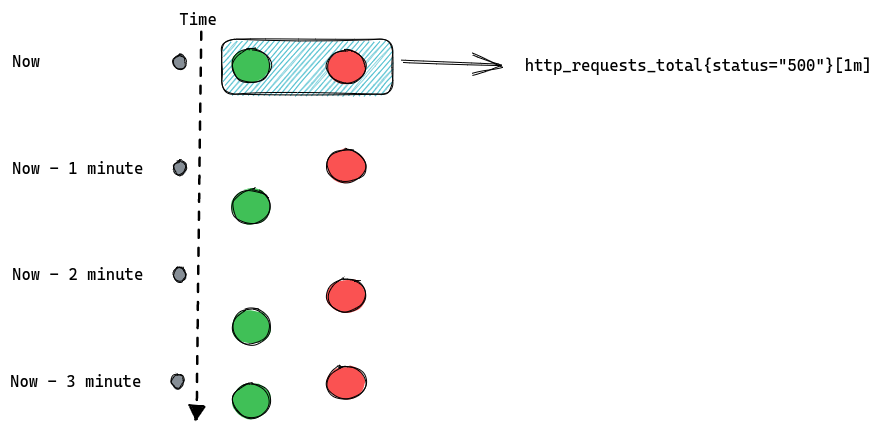
There’s obviously more to it as we can use functions and build complex queries that utilize multiple metrics in one expression. But for the purposes of this blog post we’ll stop here.
The important thing to know about instant queries is that they return the most recent value of a matched time series, and they will look back for up to five minutes (by default) into the past to find it. If the last value is older than five minutes then it’s considered stale and Prometheus won’t return it anymore.

The second type of query is a range query – it works similarly to instant queries, the difference is that instead of returning us the most recent value it gives us a list of values from the selected time range. That time range is always relative so instead of providing two timestamps we provide a range, like “20 minutes”. When we ask for a range query with a 20 minutes range it will return us all values collected for matching time series from 20 minutes ago until now.
An important distinction between those two types of queries is that range queries don’t have the same “look back for up to five minutes” behavior as instant queries. If Prometheus cannot find any values collected in the provided time range then it doesn’t return anything.
If we modify our example to request [3m] range query we should expect Prometheus to return three data points for each time series:
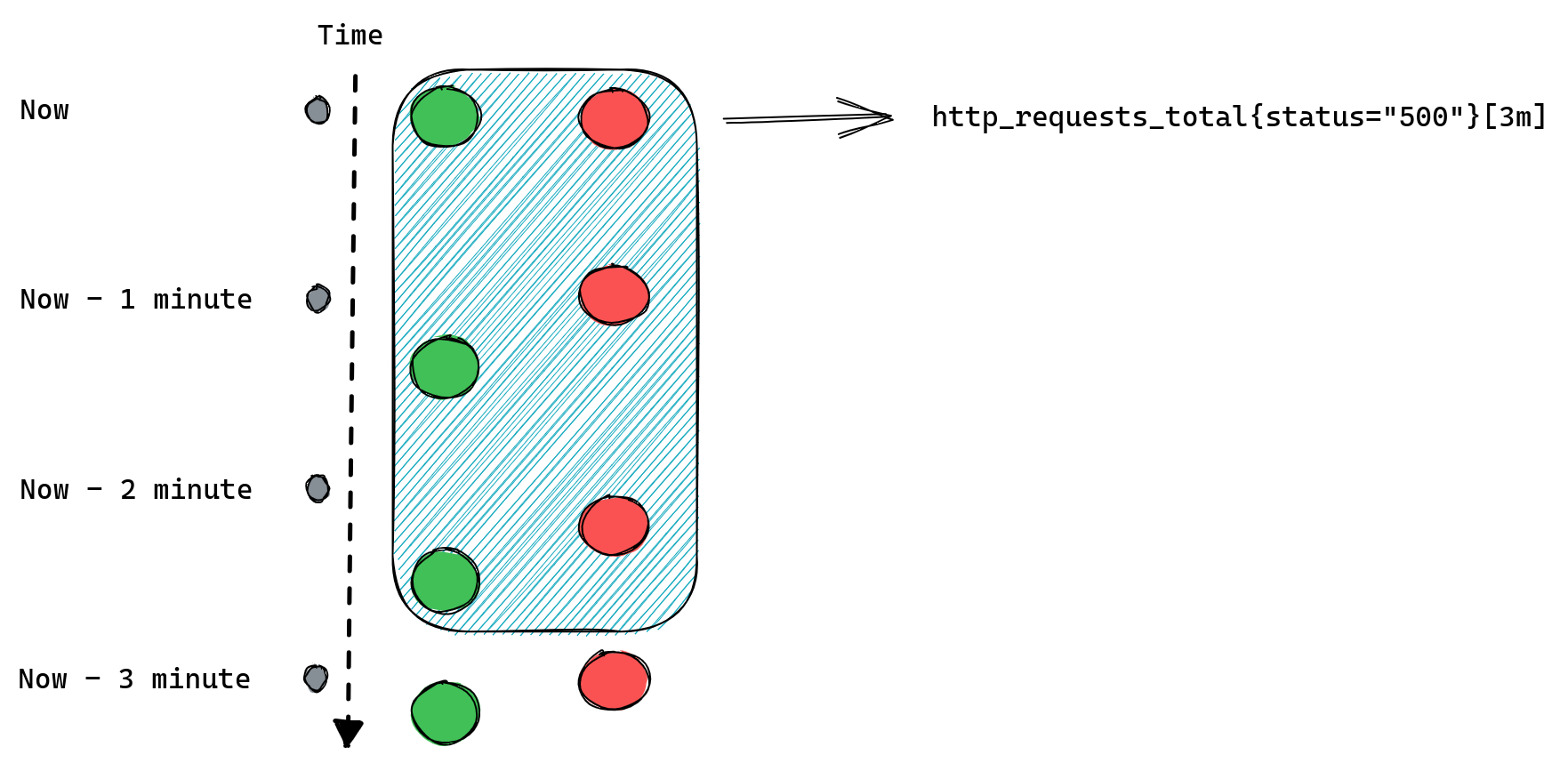
When queries don’t return anything
Knowing a bit more about how queries work in Prometheus we can go back to our alerting rules and spot a potential problem: queries that don’t return anything.
If our query doesn’t match any time series or if they’re considered stale then Prometheus will return an empty result. This might be because we’ve made a typo in the metric name or label filter, the metric we ask for is no longer being exported, or it was never there in the first place, or we’ve added some condition that wasn’t satisfied, like value of being non-zero in our http_requests_total{status=”500”} > 0 example.
Prometheus will not return any error in any of the scenarios above because none of them are really problems, it’s just how querying works. If you ask for something that doesn’t match your query then you get empty results. This means that there’s no distinction between “all systems are operational” and “you’ve made a typo in your query”. So if you’re not receiving any alerts from your service it’s either a sign that everything is working fine, or that you’ve made a typo, and you have no working monitoring at all, and it’s up to you to verify which one it is.
For example, we could be trying to query for http_requests_totals instead of http_requests_total (an extra “s” at the end) and although our query will look fine it won’t ever produce any alert.

Range queries can add another twist – they’re mostly used in Prometheus functions like rate(), which we used in our example. This function will only work correctly if it receives a range query expression that returns at least two data points for each time series, after all it’s impossible to calculate rate from a single number.
Since the number of data points depends on the time range we passed to the range query, which we then pass to our rate() function, if we provide a time range that only contains a single value then rate won’t be able to calculate anything and once again we’ll return empty results.
The number of values collected in a given time range depends on the interval at which Prometheus collects all metrics, so to use rate() correctly you need to know how your Prometheus server is configured. You can read more about this here and here if you want to better understand how rate() works in Prometheus.
For example if we collect our metrics every one minute then a range query http_requests_total[1m] will be able to find only one data point. Here’s a reminder of how this looks:
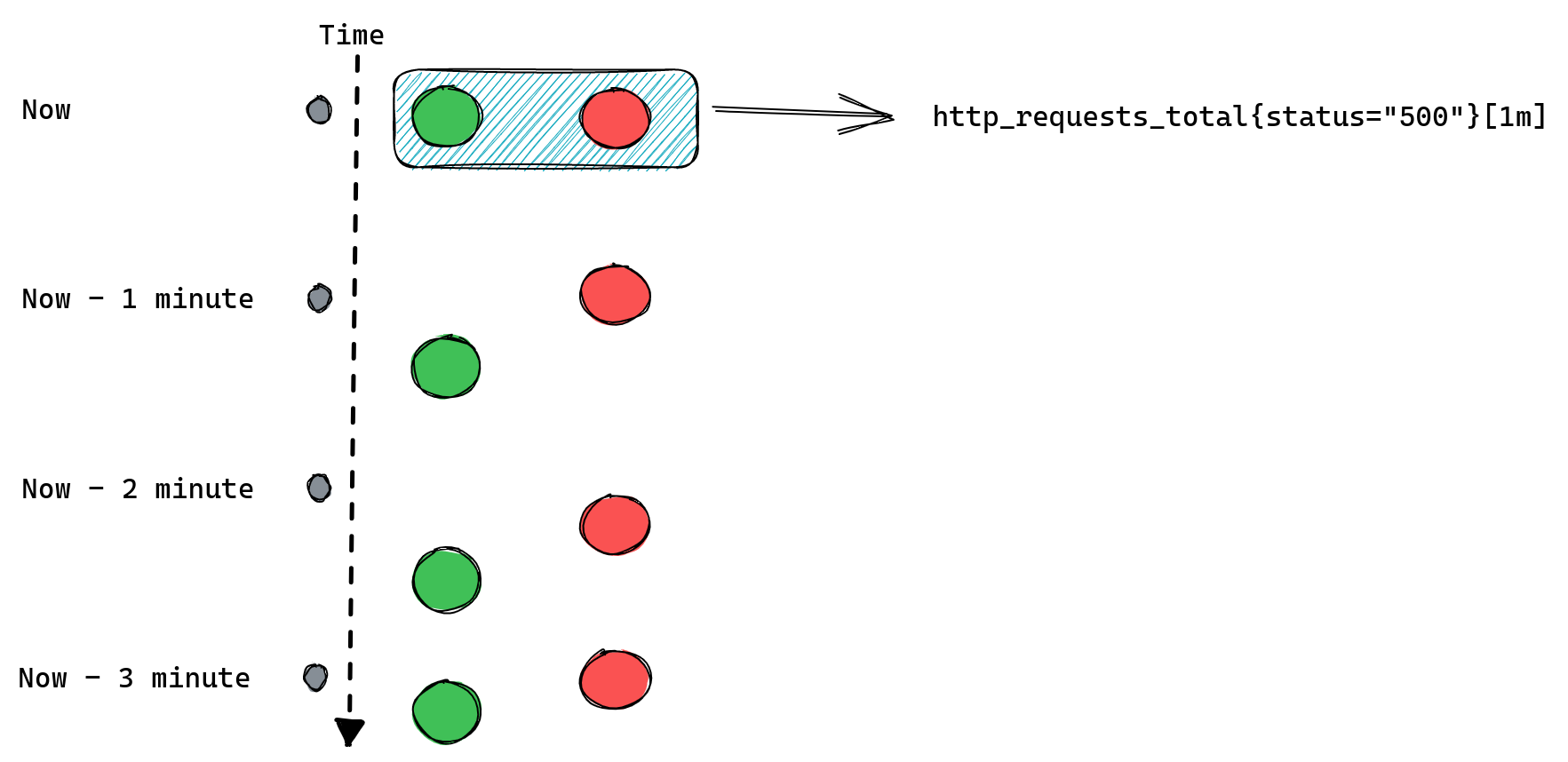
Since, as we mentioned before, we can only calculate rate() if we have at least two data points, calling rate(http_requests_total[1m]) will never return anything and so our alerts will never work.

There are more potential problems we can run into when writing Prometheus queries, for example any operations between two metrics will only work if both have the same set of labels, you can read about this here. But for now we’ll stop here, listing all the gotchas could take a while. The point to remember is simple: if your alerting query doesn’t return anything then it might be that everything is ok and there’s no need to alert, but it might also be that you’ve mistyped your metrics name, your label filter cannot match anything, your metric disappeared from Prometheus, you are using too small time range for your range queries etc.
Renaming metrics can be dangerous
We’ve been running Prometheus for a few years now and during that time we’ve grown our collection of alerting rules a lot. Plus we keep adding new products or modifying existing ones, which often includes adding and removing metrics, or modifying existing metrics, which may include renaming them or changing what labels are present on these metrics.
A lot of metrics come from metrics exporters maintained by the Prometheus community, like node_exporter, which we use to gather some operating system metrics from all of our servers. Those exporters also undergo changes which might mean that some metrics are deprecated and removed, or simply renamed.
A problem we’ve run into a few times is that sometimes our alerting rules wouldn’t be updated after such a change, for example when we upgraded node_exporter across our fleet. Or the addition of a new label on some metrics would suddenly cause Prometheus to no longer return anything for some of the alerting queries we have, making such an alerting rule no longer useful.
It’s worth noting that Prometheus does have a way of unit testing rules, but since it works on mocked data it’s mostly useful to validate the logic of a query. Unit testing won’t tell us if, for example, a metric we rely on suddenly disappeared from Prometheus.
Chaining rules
When writing alerting rules we try to limit alert fatigue by ensuring that, among many things, alerts are only generated when there’s an action needed, they clearly describe the problem that needs addressing, they have a link to a runbook and a dashboard, and finally that we aggregate them as much as possible. This means that a lot of the alerts we have won’t trigger for each individual instance of a service that’s affected, but rather once per data center or even globally.
For example, we might alert if the rate of HTTP errors in a datacenter is above 1% of all requests. To do that we first need to calculate the overall rate of errors across all instances of our server. For that we would use a recording rule:
- record: job:http_requests_total:rate2m
expr: sum(rate(http_requests_total[2m])) without(method, status, instance)
- record: job:http_requests_status500:rate2m
expr: sum(rate(http_requests_total{status=”500”}[2m])) without(method, status, instance)
First rule will tell Prometheus to calculate per second rate of all requests and sum it across all instances of our server. Second rule does the same but only sums time series with status labels equal to “500”. Both rules will produce new metrics named after the value of the record field.
Now we can modify our alert rule to use those new metrics we’re generating with our recording rules:
- alert: Serving HTTP 500 errors
expr: job:http_requests_status500:rate2m / job:http_requests_total:rate2m > 0.01
If we have a data center wide problem then we will raise just one alert, rather than one per instance of our server, which can be a great quality of life improvement for our on-call engineers.
But at the same time we’ve added two new rules that we need to maintain and ensure they produce results. To make things more complicated we could have recording rules producing metrics based on other recording rules, and then we have even more rules that we need to ensure are working correctly.

What if all those rules in our chain are maintained by different teams? What if the rule in the middle of the chain suddenly gets renamed because that’s needed by one of the teams? Problems like that can easily crop up now and then if your environment is sufficiently complex, and when they do, they’re not always obvious, after all the only sign that something stopped working is, well, silence – your alerts no longer trigger. If you’re lucky you’re plotting your metrics on a dashboard somewhere and hopefully someone will notice if they become empty, but it’s risky to rely on this.
We definitely felt that we needed something better than hope.
Introducing pint: a Prometheus rule linter
To avoid running into such problems in the future we’ve decided to write a tool that would help us do a better job of testing our alerting rules against live Prometheus servers, so we can spot missing metrics or typos easier. We also wanted to allow new engineers, who might not necessarily have all the in-depth knowledge of how Prometheus works, to be able to write rules with confidence without having to get feedback from more experienced team members.
Since we believe that such a tool will have value for the entire Prometheus community we’ve open-sourced it, and it’s available for anyone to use – say hello to pint!
You can find sources on github, there’s also online documentation that should help you get started.
Pint works in 3 different ways:
- You can run it against a file(s) with Prometheus rules
- It can run as a part of your CI pipeline
- Or you can deploy it as a side-car to all your Prometheus servers
It doesn’t require any configuration to run, but in most cases it will provide the most value if you create a configuration file for it and define some Prometheus servers it should use to validate all rules against. Running without any configured Prometheus servers will limit it to static analysis of all the rules, which can identify a range of problems, but won’t tell you if your rules are trying to query non-existent metrics.
First mode is where pint reads a file (or a directory containing multiple files), parses it, does all the basic syntax checks and then runs a series of checks for all Prometheus rules in those files.
Second mode is optimized for validating git based pull requests. Instead of testing all rules from all files pint will only test rules that were modified and report only problems affecting modified lines.
Third mode is where pint runs as a daemon and tests all rules on a regular basis. If it detects any problem it will expose those problems as metrics. You can then collect those metrics using Prometheus and alert on them as you would for any other problems. This way you can basically use Prometheus to monitor itself.
What kind of checks can it run for us and what kind of problems can it detect?
All the checks are documented here, along with some tips on how to deal with any detected problems. Let’s cover the most important ones briefly.
As mentioned above the main motivation was to catch rules that try to query metrics that are missing or when the query was simply mistyped. To do that pint will run each query from every alerting and recording rule to see if it returns any result, if it doesn’t then it will break down this query to identify all individual metrics and check for the existence of each of them. If any of them is missing or if the query tries to filter using labels that aren’t present on any time series for a given metric then it will report that back to us.
So if someone tries to add a new alerting rule with http_requests_totals typo in it, pint will detect that when running CI checks on the pull request and stop it from being merged. Which takes care of validating rules as they are being added to our configuration management system.

Another useful check will try to estimate the number of times a given alerting rule would trigger an alert. Which is useful when raising a pull request that’s adding new alerting rules – nobody wants to be flooded with alerts from a rule that’s too sensitive so having this information on a pull request allows us to spot rules that could lead to alert fatigue.
Similarly, another check will provide information on how many new time series a recording rule adds to Prometheus. In our setup a single unique time series uses, on average, 4KiB of memory. So if a recording rule generates 10 thousand new time series it will increase Prometheus server memory usage by 10000*4KiB=40MiB. 40 megabytes might not sound like but our peak time series usage in the last year was around 30 million time series in a single Prometheus server, so we pay attention to anything that’s might add a substantial amount of new time series, which pint helps us to notice before such rule gets added to Prometheus.
On top of all the Prometheus query checks, pint allows us also to ensure that all the alerting rules comply with some policies we’ve set for ourselves. For example, we require everyone to write a runbook for their alerts and link to it in the alerting rule using annotations.
We also require all alerts to have priority labels, so that high priority alerts are generating pages for responsible teams, while low priority ones are only routed to karma dashboard or create tickets using jiralert. It’s easy to forget about one of these required fields and that’s not something which can be enforced using unit testing, but pint allows us to do that with a few configuration lines.
With pint running on all stages of our Prometheus rule life cycle, from initial pull request to monitoring rules deployed in our many data centers, we can rely on our Prometheus alerting rules to always work and notify us of any incident, large or small.
GitHub: https://github.com/cloudflare/pint
Putting it all together
Let’s see how we can use pint to validate our rules as we work on them.
We can begin by creating a file called “rules.yml” and adding both recording rules there.
The goal is to write new rules that we want to add to Prometheus, but before we actually add those, we want pint to validate it all for us.
groups:
- name: Demo recording rules
rules:
- record: job:http_requests_total:rate2m
expr: sum(rate(http_requests_total[2m])) without(method, status, instance)
- record: job:http_requests_status500:rate2m
expr: sum(rate(http_requests_total{status="500"}[2m]) without(method, status, instance)
Next we’ll download the latest version of pint from GitHub and run check our rules.
$ pint lint rules.yml
level=info msg="File parsed" path=rules.yml rules=2
rules.yml:8: syntax error: unclosed left parenthesis (promql/syntax)
expr: sum(rate(http_requests_total{status="500"}[2m]) without(method, status, instance)
level=info msg="Problems found" Fatal=1
level=fatal msg="Execution completed with error(s)" error="problems found"
Whoops, we have “sum(rate(…)” and so we’re missing one of the closing brackets. Let’s fix that and try again.
groups:
- name: Demo recording rules
rules:
- record: job:http_requests_total:rate2m
expr: sum(rate(http_requests_total[2m])) without(method, status, instance)
- record: job:http_requests_status500:rate2m
expr: sum(rate(http_requests_total{status="500"}[2m])) without(method, status, instance)
$ pint lint rules.yml
level=info msg="File parsed" path=rules.yml rules=2
Our rule now passes the most basic checks, so we know it’s valid. But to know if it works with a real Prometheus server we need to tell pint how to talk to Prometheus. For that we’ll need a config file that defines a Prometheus server we test our rule against, it should be the same server we’re planning to deploy our rule to. Here we’ll be using a test instance running on localhost. Let’s create a “pint.hcl” file and define our Prometheus server there:
prometheus "prom1" {
uri = "http://localhost:9090"
timeout = "1m"
}
Now we can re-run our check using this configuration file:
$ pint -c pint.hcl lint rules.yml
level=info msg="Loading configuration file" path=pint.hcl
level=info msg="File parsed" path=rules.yml rules=2
rules.yml:5: prometheus "prom1" at http://localhost:9090 didn't have any series for "http_requests_total" metric in the last 1w (promql/series)
expr: sum(rate(http_requests_total[2m])) without(method, status, instance)
rules.yml:8: prometheus "prom1" at http://localhost:9090 didn't have any series for "http_requests_total" metric in the last 1w (promql/series)
expr: sum(rate(http_requests_total{status="500"}[2m])) without(method, status, instance)
level=info msg="Problems found" Bug=2
level=fatal msg="Execution completed with error(s)" error="problems found"
Yikes! It’s a test Prometheus instance, and we forgot to collect any metrics from it.
Let’s fix that by starting our server locally on port 8080 and configuring Prometheus to collect metrics from it:
scrape_configs:
- job_name: webserver
static_configs:
- targets: ['localhost:8080’]
Let’ re-run our checks once more:
$ pint -c pint.hcl lint rules.yml
level=info msg="Loading configuration file" path=pint.hcl
level=info msg="File parsed" path=rules.yml rules=2
This time everything works!
Now let’s add our alerting rule to our file, so it now looks like this:
groups:
- name: Demo recording rules
rules:
- record: job:http_requests_total:rate2m
expr: sum(rate(http_requests_total[2m])) without(method, status, instance)
- record: job:http_requests_status500:rate2m
expr: sum(rate(http_requests_total{status="500"}[2m])) without(method, status, instance)
- name: Demo alerting rules
rules:
- alert: Serving HTTP 500 errors
expr: job:http_requests_status500:rate2m / job:http_requests_total:rate2m > 0.01
And let’s re-run pint once again:
$ pint -c pint.hcl lint rules.yml
level=info msg="Loading configuration file" path=pint.hcl
level=info msg="File parsed" path=rules.yml rules=3
rules.yml:13: prometheus "prom1" at http://localhost:9090 didn't have any series for "job:http_requests_status500:rate2m" metric in the last 1w but found recording rule that generates it, skipping further checks (promql/series)
expr: job:http_requests_status500:rate2m / job:http_requests_total:rate2m > 0.01
rules.yml:13: prometheus "prom1" at http://localhost:9090 didn't have any series for "job:http_requests_total:rate2m" metric in the last 1w but found recording rule that generates it, skipping further checks (promql/series)
expr: job:http_requests_status500:rate2m / job:http_requests_total:rate2m > 0.01
level=info msg="Problems found" Information=2
It all works according to pint, and so we now can safely deploy our new rules file to Prometheus.
Notice that pint recognised that both metrics used in our alert come from recording rules, which aren’t yet added to Prometheus, so there’s no point querying Prometheus to verify if they exist there.
Now what happens if we deploy a new version of our server that renames the “status” label to something else, like “code”?
$ pint -c pint.hcl lint rules.yml
level=info msg="Loading configuration file" path=pint.hcl
level=info msg="File parsed" path=rules.yml rules=3
rules.yml:8: prometheus "prom1" at http://localhost:9090 has "http_requests_total" metric but there are no series with "status" label in the last 1w (promql/series)
expr: sum(rate(http_requests_total{status="500"}[2m])) without(method, status, instance)
rules.yml:13: prometheus "prom1" at http://localhost:9090 didn't have any series for "job:http_requests_status500:rate2m" metric in the last 1w but found recording rule that generates it, skipping further checks (promql/series)
expr: job:http_requests_status500:rate2m / job:http_requests_total:rate2m > 0.01
level=info msg="Problems found" Bug=1 Information=1
level=fatal msg="Execution completed with error(s)" error="problems found"
Luckily pint will notice this and report it, so we can adopt our rule to match the new name.
But what if that happens after we deploy our rule? For that we can use the “pint watch” command that runs pint as a daemon periodically checking all rules.
Please note that validating all metrics used in a query will eventually produce some false positives. In our example metrics with status=”500” label might not be exported by our server until there’s at least one request ending in HTTP 500 error.
The promql/series check responsible for validating presence of all metrics has some documentation on how to deal with this problem. In most cases you’ll want to add a comment that instructs pint to ignore some missing metrics entirely or stop checking label values (only check if there’s “status” label present, without checking if there are time series with status=”500”).
Summary
Prometheus metrics don’t follow any strict schema, whatever services expose will be collected. At the same time a lot of problems with queries hide behind empty results, which makes noticing these problems non-trivial.
We use pint to find such problems and report them to engineers, so that our global network is always monitored correctly, and we have confidence that lack of alerts proves how reliable our infrastructure is.
Tips and tricks for high-performant dashboards in Amazon QuickSight
Post Syndicated from Shekhar Kopuri original https://aws.amazon.com/blogs/big-data/tips-and-tricks-for-high-performant-dashboards-in-amazon-quicksight/
Amazon QuickSight is cloud-native business intelligence (BI) service. QuickSight automatically optimizes queries and execution to help dashboards load quickly, but you can make your dashboard loads even faster and make sure you’re getting the best possible performance by following the tips and tricks outlined in this post.
Data flow and execution of QuickSight dashboard loads
The data flow in QuickSight starts from the client browser to the web server and then flows to the QuickSight engine, which in some cases executes queries against SPICE—a Super-fast, Parallel, In-memory Calculation Engine—or in other cases directly against the database. SPICE uses a combination of columnar storage, in-memory technologies enabled through the latest hardware innovations, and machine code generation to run interactive queries on large datasets and get rapid responses.
The web server, QuickSight engine, and SPICE are auto scaled by QuickSight. This is a fully managed service—you don’t need to worry about provisioning or managing infrastructure when you want to scale up a particular dashboard from tens to thousands of users on SPICE. Dashboards built against direct query data sources may require provisioning or managing infrastructure on the customer side.
The following diagram illustrates the data flow:
Let’s look at the general execution process to understand the implications:
- A request is triggered in the browser, leading to several static assets such as JavaScript, fonts, and images being downloaded.
- All the metadata (such as visual configurations and layout) is fetched for the dashboard.
- Queries are performed, which may include setting up row-level and column-level security, or fetching dynamic control values, default parameters, and all values of drop-downs in filter controls.
- Up to your concurrency limit, the queries to render your visuals run in a specific sequence (described later in this post). If you’re using SPICE, the concurrency of queries is much higher. Pagination within visuals may lead to additional queries.
The actual execution is more complex and depends on how dashboards are configured and other factors such as the data source types, Direct Query vs. SPICE, cardinality of fields and how often data is getting refreshed etc. Many operations run in parallel and all visual-related queries are run via WebSocket, as shown in the following screenshot. Many of the steps run in the end-user’s browser, therefore there are limitations such as the number of sequences and workloads that can be pushed onto the browser. Performance may also be slightly different based on the browser type because each browser handles contention differently.
Now let’s look at many great tips that can improve your dashboard’s performance!
SPICE
Utilizing the capabilities of SPICE when possible is a great way to boost overall performance because SPICE manages scaling as well as caching results for you. We recommend using SPICE whenever possible.
Metadata
As seen in the preceding execution sequence, QuickSight fetches metadata up front for a given dashboard during the initial load. We recommend the following actions regarding metadata.
Remove unused datasets from analysis
Datasets that may have been used in the past but have no visual associated with the dashboard anymore add to the metadata payload unnecessarily. It’s likely to impact to dashboard performance.
Make sure your row-level and column-level security is performant
Row-Level security, column-level security and dynamic default parameters each require lookups to take place before the visual queries are issued. When possible, try to limit the number and the complexity of your rules datasets to help these lookups execute faster. Use SPICE for your rules dataset when possible. If you must use a direct query, make sure that the queries are optimal and that the data source you’re querying is scaled appropriately up front.
For embedded dashboards, a great way to optimize row-level security lookups is by utilizing session tags for row-level security paired with an anonymous identity. Similarly, dynamic default parameters, if used, can be evaluated in the host application up front and passed using the embedding SDK.
Calculated functions
In this section, we offer tips regarding calculated functions.
Move calculations to the data prep stage
QuickSight allows you to add calculated fields in the data prep or analysis experiences. We strongly encourage you to move as many calculations as possible to the data prep stage which will allow QuickSight to materialize calculations which do not contain aggregation or parameters into the SPICE dataset. Materializing calculated fields in the dataset helps you reduce the runtime calculations, which improves query performance. Even if you are using aggregation or parameters in your calculation, it might still be possible to move parts of the calculations to data prep. For instance, if you have a formula like the following:
You can remove the sum() and just keep the ifelse(), which will allow QuickSight to materialize (precompute) it and save it as a real field in your SPICE dataset. Then you can either add another calculation which sums it up, or just use sum aggregation once you add it to your visuals.
Generally materializing calculations that use complex ifelse logic or do string manipulation/lookups will result in the greatest improvements in dashboard performance.
Implement the simplified ifelse syntax
The ifelse function supports simplified statements. For example, you might start with the following statement:
The following simplified statement is more performant:
![]()
Use the toString() function judiciously
The toString() function has a much lower performance and is much heavier on the database engine than a simple integer or number-based arithmatic calculations. Therefore, you should use it sparingly.
Know when nulls are returned by the system and use null value customization
Most authors make sure that null conditions on calculated fields are handled gracefully. QuickSight often handles nulls gracefully for you. You can use that to your advantage and make the calculations simpler. In the following example, the division by 0 is already handled by QuickSight:
You can write the preceding code as the following:
If you need to represent nulls on visuals with a static string, QuickSight allows you to set custom values when a null value is returned in a visual configuration. In the preceding example, you could just set a custom value of 0 in the formatting option. Removing such handling from the calculated fields can significantly help query performance.

On-sheet filters vs. parameters
Parameters are seemingly a very simple construct but they can quickly get complicated, especially when used in nested calculation functions or when used in controls. Parameters are all evaluated on the fly, forcing all the dependencies to be handled real time. Ask yourself if each parameter is really required. In some cases, you may be able to replace them with simple dropdown control, as shown in the following example for $market.

Instead of creating a control parameter to use in a calculated field, you might be able to use the field with a dropdown filter control.
Text field vs. Dropdown (or List) filter controls
When you are designing an analysis, you can add a filter control for the visuals you want to filter. if the data type of the field is string, you have several choices for the type of control filter. Text field which displays a text box where you can enter a single entry or multiple entries is suggested for the better performance, rather than Dropdown (or List) which requires to fetch the values to populate a list that you can select a single or multiple values.
On-sheet controls
The control panel at the top of the dashboard is collapsible by default, but this setting allows you to have an expanded state while publishing the dashboard. If this setting is enabled, QuickSight prioritizes the calls in order to fetch the controls’ values before the visual loads. If any of the controls have high cardinality, it could impact the performance of loading the dashboard. Evaluate this need against the fact that QuickSight persists last-used control values and the reader might not actually need to adjust controls as a first step.
Visual types: Charts
In this section, we provide advice when using Charts.
Use ‘Hide the “other” category’ when your dimension has less than the cutoff limit
You can choose to limit how many data points you want to display in your visual, before they are added to the other category. This category contains the aggregated data for all the data beyond the cutoff limit for the visual type you are using – either the one you impose or the one based on display limits. If you know your dimension has less than the cutoff limit, use this option. This will improve your dashboard performance.
The other category does not show on scatter plots, heat maps, maps, tables (tabular reports), or key performance indicators (KPIs). It also doesn’t show on line charts when the x-axis is a date.
Visual types: Tables and pivot tables
In this section, we provide advice when using tables and pivot tables.
Use the Values field well when displaying a raw table view
If you want to output all the raw data into table, you can use Group by fields, Values fields, or a mix of them. The most performant approach is set every field into Values. When using Group by, a query is first run under the hood followed by the Group by function, therefore all the data is pulled from the database, which is expensive.
Deploy a minimal set of rows, columns, metrics, and table calculations
If you include too many combinations of rows, columns, metrics, and table calculations in one pivot table, you risk overwhelming the viewer. You can also run into the computational limitations of the underlying database. To reduce the level of complexity and potential errors, you can take the following actions:
- Apply filters to reduce the data included in for the visual
- Use fewer fields in the Row and Column field wells
- Use as few fields as possible in the Values field well
- Create additional pivot tables so that each displays fewer metrics
- Reduce subtotals, totals and conditional formatting when possible
Uncollapsed columns are always the simplest case and will likely remain more performant outside of a few cases.
Visual queries sequence
The execution of the individual visual sequence is left to right, then top to bottom. Understanding the sequence of execution can be helpful: you can rearrange visuals on your dashboard without losing the context. Place heavier visuals further down in the dashboard, and place lightweight KPI and insight visuals near the top to display “above-the-fold” content sooner, which improves the dashboard performance’s perception for your readers.
Embedding
Our final set of recommendations are in regards to embedding.
Remove user management flows from the critical path
Most times, user management and authentication flows (such as DescribeUser and RegisterUser APIs) can run asynchronously on the host application.
Consider registering the user in advance before the actual embedding, so that the overhead is removed from every analytics page visit.
Authenticate the user on your website in advance, and acquire any Amazon Cognito or AWS Security Token Service (Amazon STS) session tokens (if required) in advance (for example, at user login time or home page visit). This reduces additional runtime latency overhead when a user visits an analytics page.
Move workloads from clients to the web server or backend services
If a QuickSight dashboard is embedded on a webpage on the host application, which performs other activities too, play close attention to the sequence of API calls on the host. The QuickSight dashboard load might be gated by other heavy API calls on the host application. Move the logic to the web server or backend services as much as possible to limit contention on the browser.
Don’t tear down the embedding iFrame when the user navigates away from analytics section
When the user moves temporarily to a non-analytics page of your web application (especially in single-page applications), instead of removing the embedding iframe from DOM, you can hide it from the user while keeping the iFrame in the page DOM elements. This allows you to resume the same session when the user navigates back to analytics section of your application, and they don’t need to wait for reload.
Use navigateToDashboard() and navigateToSheet() whenever possible
If you have multiple dashboards on your host application that don’t need to load concurrently, you can optimize the authentication flow by utilizing two APIs we expose, navigateToDashboard() or navigateToSheet(), in our JavaScript SDK. These APIs reuse the same iFrame for each load, while reusing the authentication token.
This technique has proven to be very effective for many of our embedding users.
For more information about these APIs, refer to Amazon QuickSight Embedding SDK.
Conclusion
In this post, we shared some tips and tricks for tuning the performance of your QuickSight dashboards. In 2021, we doubled our SPICE data limits to 500 million rows of data per dataset. In addition, incremental data refresh is available for SQL-based data sources such as Amazon Redshift, Amazon Athena, Amazon RDS, Amazon Aurora, PostgreSQL, MySQL, Oracle, SQL Server, MariaDB, Presto, Teradata or Snowflake up to every 15 minutes, which cuts down time between data updates by 75%. In 2022, we continue to innovate on your behalf to make QuickSight dashboard loads even more performant.
We look forward to your feedback on how these tips and tricks helped your dashboards load faster.
About the Authors
 Shekhar Kopuri is a Senior Software Development Manager for Amazon QuickSight. He leads the front platform engineering team that focusses on various aspects of front end experience including website performance. Before joining AWS, Shekhar led development of multiple provisioning and activation network OSS applications for a large global telecommunications service provider.
Shekhar Kopuri is a Senior Software Development Manager for Amazon QuickSight. He leads the front platform engineering team that focusses on various aspects of front end experience including website performance. Before joining AWS, Shekhar led development of multiple provisioning and activation network OSS applications for a large global telecommunications service provider.
 Blake Carroll is a Senior Frontend Engineer for Amazon QuickSight. He works with the frontend platform engineering team with a focus on website performance and has previously been the frontend lead for initial reporting and theming functionality in QuickSight. Prior to joining Amazon, Blake was a co-founder in the digital interactive agency space working with national brands to produce creative web experiences.
Blake Carroll is a Senior Frontend Engineer for Amazon QuickSight. He works with the frontend platform engineering team with a focus on website performance and has previously been the frontend lead for initial reporting and theming functionality in QuickSight. Prior to joining Amazon, Blake was a co-founder in the digital interactive agency space working with national brands to produce creative web experiences.
 Vijay Chaudhari is a Senior Software Development Engineer for Amazon QuickSight, AWS’ cloud-native, fully managed BI service. Vijay started his career with IBM, writing software for the Information Management group. At Amazon, he has built backend applications for retail systems, and near real-time data pre-computation, reporting and analytics systems at Amazon scale. He is passionate about learning and solving new customer problems, and helping them adopt cloud native technologies.
Vijay Chaudhari is a Senior Software Development Engineer for Amazon QuickSight, AWS’ cloud-native, fully managed BI service. Vijay started his career with IBM, writing software for the Information Management group. At Amazon, he has built backend applications for retail systems, and near real-time data pre-computation, reporting and analytics systems at Amazon scale. He is passionate about learning and solving new customer problems, and helping them adopt cloud native technologies.
 Wakana Vilquin-Sakashita is Specialist Solution Architect for Amazon QuickSight. She works closely with customers to help making sense of the data through visualization. Previously Wakana worked for S&P Global assisting customers to access data, insights and researches relevant for their business.
Wakana Vilquin-Sakashita is Specialist Solution Architect for Amazon QuickSight. She works closely with customers to help making sense of the data through visualization. Previously Wakana worked for S&P Global assisting customers to access data, insights and researches relevant for their business.
[$] Cleaning up dying control groups, 2022 edition
Post Syndicated from original https://lwn.net/Articles/895431/
Control groups are a useful system-management feature, but they can also
consume a lot of resources, especially if they hang around on the system
after they have been deleted. Roman Gushchin described the problems that can result at the
2019 Linux Storage, Filesystem, Memory-management and BPF Summit (LSFMM);
he returned during the 2022 LSFMM to revisit
the issue, especially as it relates to the memory controller. Progress has
been made, but the problem is not yet solved.
[$] CXL 2: Pooling, sharing, and I/O-memory resources
Post Syndicated from original https://lwn.net/Articles/894626/
During the final day of the 2022 Linux Storage,
Filesystem, Memory-management and BPF Summit (LSFMM), attention in the
memory-management track turned once again to the challenges posed by the
upcoming Compute Express Link (CXL) technology. Two sessions looked at
different problems posed by CXL memory, which can come and go over the
operation of the system. CXL offers a lot of flexibility, but changes will
be needed for the kernel to be able to take advantage of it.
Huang: Rust: A Critical Retrospective
Post Syndicated from original https://lwn.net/Articles/895773/
Andrew ‘bunnie’ Huang has posted an extensive review of
the Rust language derived from the experience of writing “over
100k lines” of code.
Rust is a difficult language for authoring code because it makes
these “cheats” hard – as long as you have the discipline of not
using “unsafe” constructions to make cheats easy. However, really
hard does not mean impossible – there were definitely some cheats
that got swept under the rug during the construction of Xous.This is where Rust really exceeded expectations for me. The
language’s structure and tooling was very good at hunting down
these cheats and refactoring the code base, thus curing the cancer
without killing the patient, so to speak. This is the point at
which Rust’s very strict typing and borrow checker converts from a
productivity liability into a productivity asset.
CVE-2022-22972: Critical Authentication Bypass in VMware Workspace ONE Access, Identity Manager, and vRealize Automation
Post Syndicated from Jake Baines original https://blog.rapid7.com/2022/05/19/cve-2022-22972-critical-authentication-bypass-in-vmware-workspace-one-access-identity-manager-and-vrealize-automation/

On May 18, 2022, VMware published VMSA-2022-0014 on CVE-2022-22972 and CVE-2022-22973. The more severe of the two vulnerabilities is CVE-2022-22972, a critical authentication bypass affecting VMware’s Workspace ONE Access, Identity Manager, and vRealize Automation solutions. The vulnerability allows attackers with network access to the UI to obtain administrative access without the need to authenticate. CVE-2022-22972 may be chained with CVE-2022-22973 to bypass authentication and obtain root access. A full list of affected products is available in VMware’s advisory.
At time of writing, there is no public proof of concept for CVE-2022-22972, and there have been no reports of exploitation in the wild. We expect this to change quickly, however, since Rapid7 researchers have seen similar VMware vulnerabilities come under attack quickly in recent weeks. In April 2022, we published details on CVE-2022-22954, a server-side template injection flaw that was widely exploited by threat actors targeting internet-facing VMware Workspace ONE and Identity Manager applications.
In conjunction with VMware’s advisory on May 18, the US Cybersecurity and Infrastructure Agency (CISA) published Emergency Directive 22-03 in response to VMSA-2022-0014. The directive requires all “Federal Civilian Executive Branch” agencies to either apply the patch or remove affected VMware installations from agency networks by May 24, 2022. CISA also released an additional alert emphasizing that threat actors are known to be chaining recent VMware vulnerabilities — CVE-2022-22954 and CVE-2022-22960 — to gain full control of vulnerable systems. CISA’s alert notes that the new vulnerabilities in VMSA-2022-0014 are likely to be exploited in the wild quickly:
Due to the [likely] rapid exploitation of these vulnerabilities, CISA strongly encourages all organizations with affected VMware products that are accessible from the internet — that did not immediately apply updates — to assume compromise.
Mitigation guidance
VMware customers should patch their Workspace ONE Access, Identity Manager, and vRealize Automation installations immediately, without waiting for a regular patch cycle to occur. VMware has instructions here on patching and applying workarounds.
Additionally, if your installation is internet-facing, consider taking steps to remove direct access from the internet. It may also be prudent to follow CISA’s guidance on post-exploitation detection methods found in Alert (AA22-138B).
Rapid7 customers
InsightVM and Nexpose customers can assess their VMware Workspace ONE Access and Identity Manager systems’ exposure to CVE-2022-22972 and CVE-2022-22973 with authenticated vulnerability checks for Unix-like systems available in the May 19, 2022 content release. (Note that VMware Workspace ONE Access is only able to be deployed on Linux from 20.x onward.) Additional vulnerability coverage will be evaluated as the need arises.
Eurovision 2022, the Internet effect version
Post Syndicated from João Tomé original https://blog.cloudflare.com/eurovision-2022-internet-trends/


There’s only one song contest that is more than six decades old and not only presents many new songs (ABBA, Celine Dion, Julio Iglesias and Domenico Modugno shined there), but also has a global stage that involves 40 countries — performers represent those countries and the public votes. The 66th edition of the Eurovision Song Contest, in Turin, Italy, had two semi-finals (May 10 and 12) and a final (May 14), all of them with highlights, including Ukraine’s victory. The Internet was impacted in more than one way, from whole countries to the fan and official broadcasters sites, but also video platforms.
On our Eurovision dedicated page, it was possible to see the level of Internet traffic in the 40 participant countries, and we tweeted some highlights during the final.
#Ukraine just won the #Eurovision in Turin, #Italy
Video platforms DNS traffic in Ukraine today, during the event, was 22% higher at 23:00 CEST compared to the previous Saturday. The @Eurovision final is being transmitted live via YouTube.
— @Cloudflare data. pic.twitter.com/juBmtDj1FP— Cloudflare Radar (@CloudflareRadar) May 14, 2022
First, some technicalities. The baseline for the values we use in the following charts is the average of the preceding week, except for the more granular minute by minute view that uses the traffic average of May 9 and 10 as baseline. To estimate the traffic to the several types of websites from the 40 participating countries, we use DNS name resolution data. In this blog post, we’re using CEST, Central European Summer Time.
It’s not often that an entertainment event has an impact on a country’s Internet. So, was there an impact on Eurovision nights?
Let’s start with aggregate Internet traffic to the 40 participant countries (Australia included). In the first May 10 semi-final, there seems to be a slight decrease in traffic during the contest — it makes sense if we think that most people were probably watching the broadcast on national TV (and not on YouTube, that was also transmitting live the event). Traffic was lower than in the previous period between 21:00 and 23:00 (the event was between 21:00 to 23:14), but it was back to normal at 23:00.

For the second semi-final that trend is less clear. But the May 14 final (that lasted from 21:00 CEST to 01:10) told a different story. Traffic was 6% lower than on the previous Saturday after 21:00, mostly around 22:00, and after 23:15 it was actually higher (between 4% and 6%) than before and continued that way until 02:00.
What happened at that 23:15 time in Eurovision? The last of the 25 songs at the contest was Estonia’s “Hope”, by Stefan, and it ended at 23:14 (also in this blog post we will also see how 23:16 was the highest spike in terms of DNS traffic to fan websites during the final). This is the Internet traffic in the participating countries on May 14 chart:
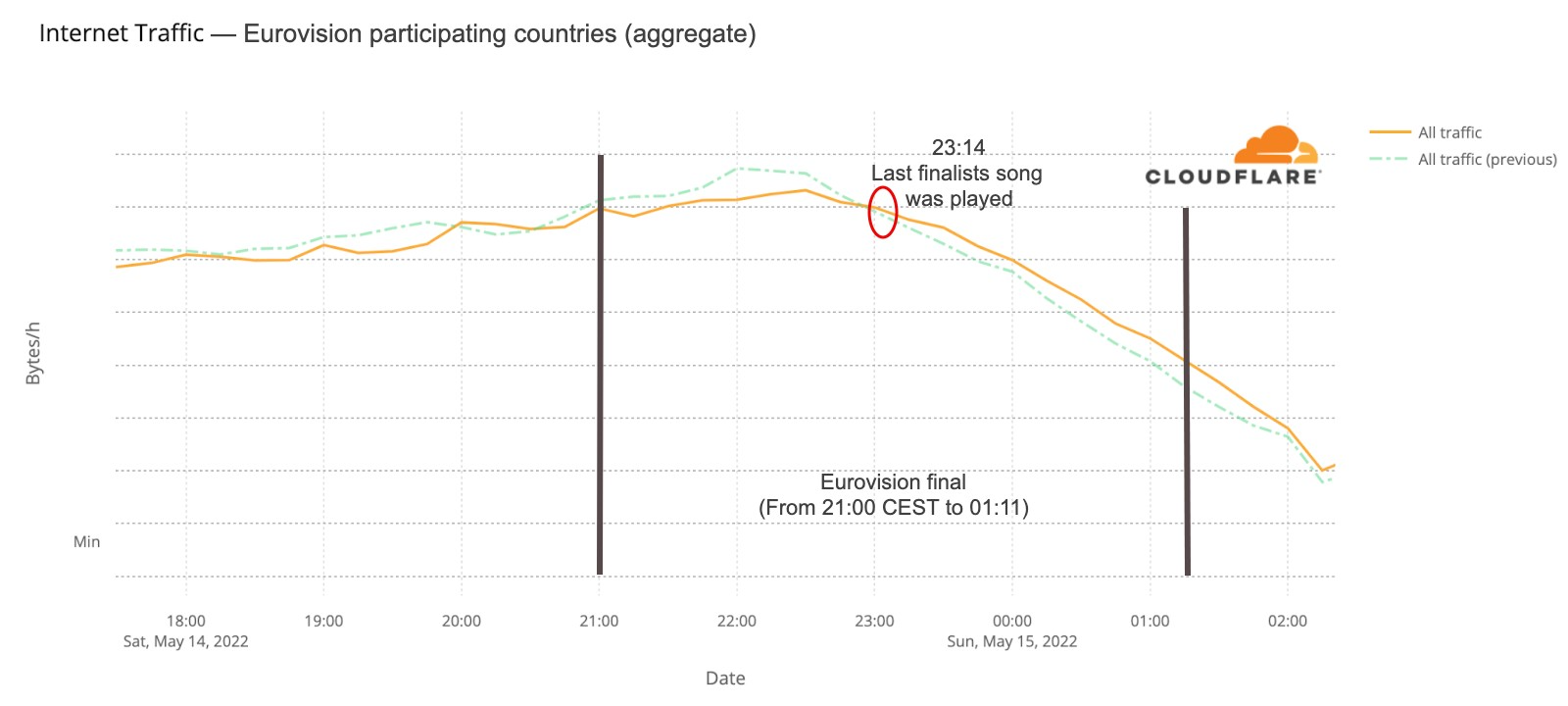
There were several countries that showed similar impact in terms of traffic change during at least the final. France, UK, Germany, Iceland, Greece and Switzerland are examples.
Eurovision & the UK
The UK was one of the countries where there seems to be more impact during the time of the grand final — last year, according to the ratings, eight million were watching the BBC transmission with the commentator Graham Norton. Traffic started to drop to lower levels than usual at 20:30 (a few minutes before the final) and was 20% lower at 22:00, starting to go closer to normal levels after 23:00, when the set of 25 finalists’ songs came to an end.
Here’s the UK’s Internet traffic trend during the Eurovision May 14 final:

Fan sites: what a difference a winner makes
The most obvious thing to check in terms of impact are the fan websites. Eurovision has many, some general (there’s the OGAE, General Organisation of Eurovision Fans), others more local. And DNS traffic to them was clearly impacted.
The first semi-final, on May 10, had 33x more traffic than in the average of the previous week, with a clear 22:00 CEST spike. But the second semi-final, May 12, topped that, with 42x more traffic at the same time. The final, with the 25 finalists, clearly surpassed that and at 22:00 traffic was already 70x. But because the final was much longer (in the semi-finals it was around 23:00 that the finalists were announced), the peak was reached at 23:00, with 86x more traffic than usual.

“We have a winner. The winner of the Eurovision Song Contest 2022 is… Ukraine!”.
— Alessandro Cattelan, Laura Pausini and Mika at 01:01 CEST, May 15, 2022.
Saturday’s final was more than four hours long (the semi-finals took little over two hours), and it finished a few minutes after 01:00 CEST. DNS traffic to fan websites dropped from 86x to 45x at midnight, but it went up again to 49x more traffic when it was already 01:00 CEST in most of Europe and Ukraine was announced the winner of Eurovision 2022. This next chart shows Saturday’s May 14 final traffic change to fan sites:

We can also clearly see that on Sunday morning, at 09:00, there was a 20x peak to fan sites, and also at 11:00 (17%).
Now, let’s go deeper by looking at a minute by minute view (the previous charts show hourly data) of DNS traffic to fan sites. In the two semi-finals it’s easy to see that the moment the finalists were announced, and the event was ending, around 23:12, was when traffic was higher. Here’s what the May 10 (yellow) and May 12 (green) two semi-finals fan sites growth looked like:

We can also spot some highlights in fan sites during the semi-final besides the finalists’ announcement, which we saw were definitely the most popular moments of the two nights. First, on May 10 there was more traffic before the event (21:00) than on May 12, so people seem to have greater expectations of the first Eurovision 2022 event of the week. In terms of spikes (before the winners’ announcements), we created a list of moments in time with more interest to the fan websites and connected them to the events that were taking place at that time in Eurovision (ordered by impact):
First semi-final, May 10
#1. 22:47 Sum up of all the songs.
#2. 22:25 Norway’s song (Subwoolfer, “Give That Wolf a Banana”).
#3. 21:42 Bulgaria’s song (Intelligent Music Project, “Intention”).
#4. 21:51 Moldova’s song (Zdob și Zdub and Advahov Brothers, “Trenulețul”).
#5. 22:20 Greece’s song (Amanda Georgiadi Tenfjord, “Die Together”).
Second semi-final, May 12
#1. 21:22 Between Serbia (Konstrakta, “In corpore sano”) and Azerbaijan (Nadir Rustamli, “Fade to Black”).
#2. 22:48 Voting period starts.
#3. 22:30 Czech Republic’s song (We Are Domi, “Lights Off”).
#4. 22:38 Laura Pausini & Mika performing (“Fragile” Sting cover song).
#5. 22:21 Belgium’s song (Jérémie Makiese, “Miss You”).
How about the May 14 final? This chart (followed by a ranking list) shows DNS traffic spikes in fan sites on Saturday’s final:
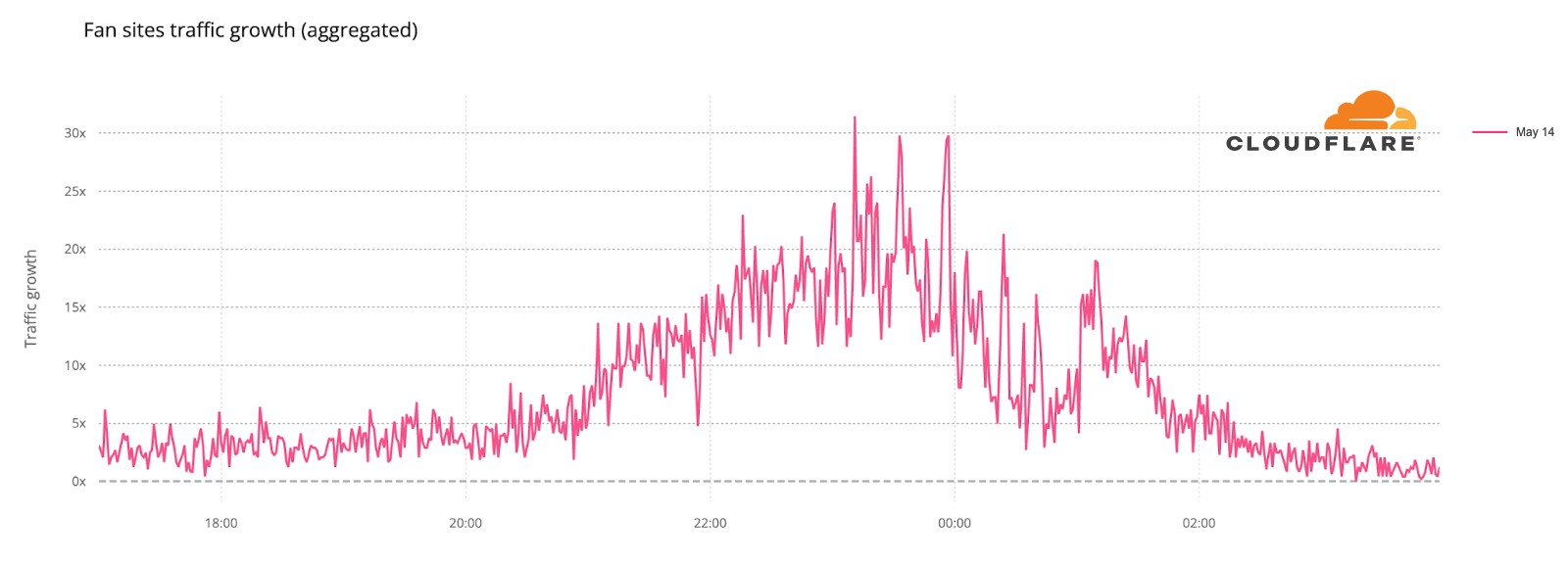
Final, May 14
#1. 23:11 Between Serbia (Konstrakta, “In corpore sano”) and Estonia (Stefan, “Hope”).
#2. 23:33 Sum up of all the songs.
#3. 23:57 Voting ended.
#4. 23:19 Sum up of all the songs.
#5. 23:01 Ending of the United Kingdom’s song (Sam Ryder, “Space Man”).
no words, just #teamSPACEMAN👩🚀 pure joy backstage after #Eurovision @SamRyderMusic @grahnort @BBCiPlayer pic.twitter.com/UMplMpFeXl
— BBC Eurovision🇬🇧 | 👩🚀#teamSPACEMAN (@bbceurovision) May 15, 2022
(UK’s performer and representative Sam Ryder with Graham Norton, the BBC commentator of Eurovision since 2009 — the BBC broadcasts the event since 1956.)
The broadcasters show
How about official national broadcaster websites? Around 23:00 CEST traffic to the aggregate of 40 broadcasters was generally higher on the semi-finals and final nights (represented in grey on the next chart). That’s more clear on the final at 23:00, when DNS traffic was 18% higher than in the previous Saturday (and 50% compared to the previous day). During the semi-finals the difference is more subtle, but at 23:00 traffic in both May 10 and 12 traffic was ~6% higher than in previous days.

When we focus on the minute by minute view also on the broadcaster sites but on the three Eurovision evenings, the highest growth in traffic is also during the final (like we saw in the fan sites), mainly after 23:00, which seems normal, considering that the final was much longer in time than the semi-finals that ended around that time.

During the final (represented in pink in the previous chart), there were some clear spikes. We’ve added them to a ranking that also shows what was happening in the event at that time.
Broadcaster site spikes. Final, May 14
#1. 21:52 Best moments clip of the two semi-finals
#2. 21:00 Contest starts
#3. 00:24 Sam Ryder, the UK representative (with the song “Space Man”) being interviewed after reaching the #1 in the voting process.
#4. 01:09 Ukraine’s (Kalush Orchestra, “Stefania”) performance as the winner
#5. 01:02 Ukraine was announced as the Eurovision 2022 winner.
Video platforms: the post-final growth
Eurovision uses video platforms like YouTube and TikTok to share all the songs, clips of the events and performers and there was also a live transmission on YouTube of the three nights. Given that, we looked at DNS traffic to the video platforms in an aggregate for the 40 participating countries. So, was there an impact to this well known and high performing social and video platforms? The short answer is: yes.
The final was also the most evident example, especially after 23:15, when all the 25 finalists songs already performed and the event had two more hours of non-participant performances, video clips that summarize the songs and the voting process — the famous moment in Europe to find out who will get from each of the 40 participant countries the maximum of 12 points.
In this comparison between the semi-finals and final day, we can see how on May 10, the day of the first semi-final, video platform traffic had more growth before the contest started, which is not that surprising given that it was the first Eurovision 2022 event and there was perhaps curiosity to check who were the other contestants (by then Eurovision had videos of them all on YouTube).

But the May 14 final shows more DNS traffic growth than the other Eurovision days after 23:16 (as we saw before, that was the time when all the finalists’ songs had already been performed). The difference in traffic compared to the semi-finals was higher at 1:11 CEST. That was the moment that the final came to an end on Saturday night, and at that time it reached 31% more traffic to video platforms than on May 10, and 38% than on May 12.
Australia’s impact (with an eight hours difference)
Australia was one of the 40 participants, and it had a major time difference (there’s an eight-hour difference to CEST). Continuing to look at video platforms, DNS traffic in Australia was 22% higher at 23:00 CEST (07:00 local time) than it was in the previous Saturday and continued high around 17% of increase a few hours after. Before the 23:00 peak, traffic was 20% higher at 22:00 and 17% at 21:00, when the event was beginning.

The winners & social media
Social media in general in the 40 participating countries wasn’t as impacted, but there was a 01:00 CEST spike during the final at around the time the decision to choose the winner was between Ukraine and the UK — at 01:01 Ukraine was announced the winner of Eurovision 2022.

We can also see an impact on social media in Ukraine, when Kalush Orchestra’s “Stefania” song was announced the winner at Saturday’s, May 14, final (it was already after midnight, May 15). The usual traffic slowing down night trend that is seen in other days was clearly interrupted after 01:02 CEST (02:02 local time in Ukraine).
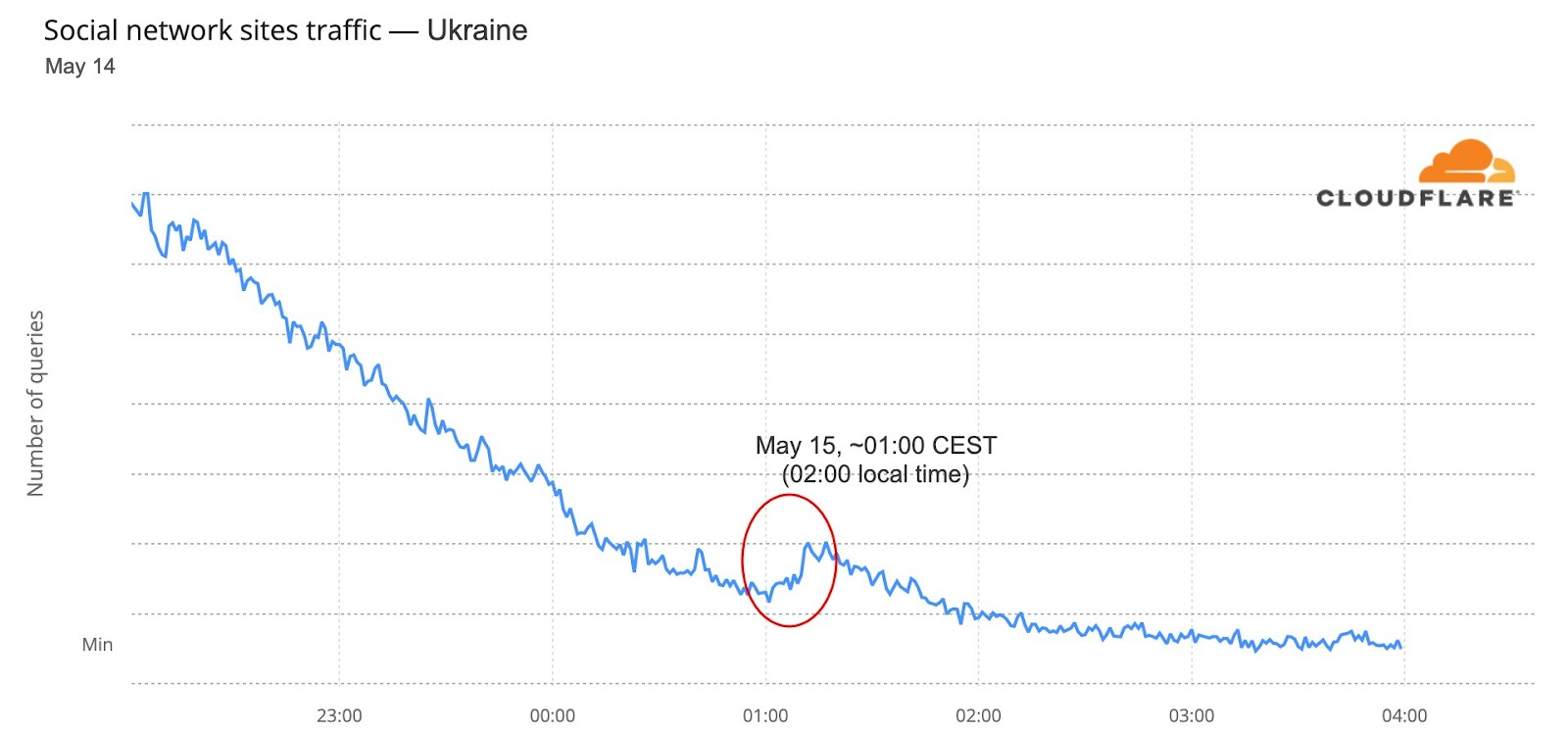
Conclusion: the Eurovision effect
When an event like Eurovision happens, there are different patterns on the Internet in the participating countries, usually all in Europe (although this year Australia was also there). Fan and broadcaster websites have specific impact because of the event, but in such a multimedia event, there are also some changes in video platforms’ DNS traffic.
And that trend goes as far as the Internet traffic of the participating countries at a more general level, something that seems to indicate that people, at least for some parts of Eurovision and in some countries, were more focused on their national TV broadcast.
The Internet is definitely a human-centric place, as we saw before in different moments like the 2022 Oscars, the Super Bowl, French elections, Ramadan or even the war on Ukraine and the impact on the open Internet in Russia.
Security updates for Thursday
Post Syndicated from original https://lwn.net/Articles/895771/
Security updates have been issued by Fedora (microcode_ctl, rubygem-nokogiri, and vim), Mageia (htmldoc, python-django, and python-oslo-utils), Red Hat (container-tools:2.0, kernel, kernel-rt, kpatch-patch, and pcs), SUSE (ardana-barbican, grafana, openstack-barbican, openstack-cinder, openstack-heat-gbp, openstack-horizon-plugin-gbp-ui, openstack-ironic, openstack-keystone, openstack-neutron-gbp, python-lxml, release-notes-suse-openstack-cloud, autotrace, curl, firefox, libslirp, php7, poppler, slurm_20_11, and ucode-intel), and Ubuntu (bind9, gnome-control-center, and libxrandr).
3-те най важни стъпки при покупката на недвижим имот
Post Syndicated from VassilKendov original http://kendov.com/3-%D1%82%D0%B5-%D0%BD%D0%B0%D0%B9-%D0%B2%D0%B0%D0%B6%D0%BD%D0%B8-%D1%81%D1%82%D1%8A%D0%BF%D0%BA%D0%B8-%D0%BF%D1%80%D0%B8-%D0%BF%D0%BE%D0%BA%D1%83%D0%BF%D0%BA%D0%B0%D1%82%D0%B0-%D0%BD%D0%B0-%D0%BD/
3-те най важни стъпки при покупката на недвижим имот
1. Осигуряване на финансиране
2. Избор на имот
3. Предварителен договор
За срещи и консултации по банкови неволи, моля използвайте посочената форма.
[contact-form-7]
Изпълните ли тези 3 стъпки както трябва, шансът за измама или проблеми по покупката на недвиим имот става минимален
Най честите проблеми при всяка от стъпките са следните:
1.При осигуряване на финансиране – тази стъпка често се изпълнява втора (след дефакто избран вече имот), но не трябва да бъде така. Това Ви кара да бързате при осигуряването на финансиране, което увеличава разходате по кредита.
Кредитните консултанти са за предпочитане пред банковите служители. Кредитните консултанти са на Ваша страна, докато служителите защитават интереса на конкретна банка. Хубаво е да получите оферти от няколко банки и да се запознаете с клаузите на договора, преди да го подпишете. Все пак инвестирате спестяванията си и ще плащате 20 години. Добре е да сте информирани в детайли по клаузите на договора.
2. Изборът на имот – тук повечето проблеми идват от брокерите на недвижими имоти и информацията, която те укриват или изменят. Напослетък се налага схемата в която се твърди, че при продажба на ново строителство, не се взима комисион от купувача, но реално Ви продават на по-висока цена, в която е включен комисиона на брокера
3. Предварителен договор – битува схващането, че “адвоката на агенцията” ще го изготви безплатно.
Има наредба за минималните адвокатски хонорари. Мислите ли, че адвокат ще свърши нещо “безплатно”, което по тарифа струва между 1200 и 1600 лева?
Самия брокер получава между 2 и 3% комисион, да тов акоето прави, а адвоката проверява имота, проверява фирмата и изготвя договора безплатно?!?
Бъдете реалисти. Ако ще се случва измама, то тя ще бъде на ниво предварителен договор.
СЪВЕТВАМ ВИ АДВОКАТА ДА Е ПЛАТЕН ОТ ВАС.
Безплатно е само сиренето в капана за мишки
Следващото видео ще бъде на тема – Спасяват ли се спестяванията от инфлацията, чрез покупка на недвиим имот? В кои случаи това е оправдано и рентабилно?
Ако информацията Ви е била полезна, моля споделете статията във ФБ и се абонирайте за канала в Youtube – https://www.youtube.com/channel/UChh1cOXj_FpK8D8C0tV9GKg
Васил Кендов
финансов консултант
The post 3-те най важни стъпки при покупката на недвижим имот appeared first on Kendov.com.
Websites that Collect Your Data as You Type
Post Syndicated from Bruce Schneier original https://www.schneier.com/blog/archives/2022/05/websites-that-collect-your-data-as-you-type.html
A surprising number of websites include JavaScript keyloggers that collect everything you type as you type it, not just when you submit a form.
Researchers from KU Leuven, Radboud University, and University of Lausanne crawled and analyzed the top 100,000 websites, looking at scenarios in which a user is visiting a site while in the European Union and visiting a site from the United States. They found that 1,844 websites gathered an EU user’s email address without their consent, and a staggering 2,950 logged a US user’s email in some form. Many of the sites seemingly do not intend to conduct the data-logging but incorporate third-party marketing and analytics services that cause the behavior.
After specifically crawling sites for password leaks in May 2021, the researchers also found 52 websites in which third parties, including the Russian tech giant Yandex, were incidentally collecting password data before submission. The group disclosed their findings to these sites, and all 52 instances have since been resolved.
“If there’s a Submit button on a form, the reasonable expectation is that it does something — that it will submit your data when you click it,” says Güneş Acar, a professor and researcher in Radboud University’s digital security group and one of the leaders of the study. “We were super surprised by these results. We thought maybe we were going to find a few hundred websites where your email is collected before you submit, but this exceeded our expectations by far.”
Research paper.
A teaspoon of computing in every subject: Broadening participation in computer science
Post Syndicated from Sue Sentance original https://www.raspberrypi.org/blog/guzdial-teaspoon-computing-tsp-language-broadening-participation-school/
From May to November 2022, our seminars focus on the theme of cross-disciplinary computing. Through this seminar series, we want to explore the intersections and interactions of computing with all aspects of learning and life, and think about how they can help us teach young people. We were delighted to welcome Prof. Mark Guzdial (University of Michigan) as our first speaker.

Mark has worked in computer science (CS) education for decades and won many awards for his research, including the prestigious ACM SIGCSE Outstanding Contribution to Computing Education award in 2019. He has written literally hundreds of papers about CS education, and he authors an extremely popular computing education research blog that keeps us all up to date with what is going on in the field.

In his talk, Mark focused on his recent work around developing task-specific programming (TSP) languages, with which teachers can add a teaspoon (also abbreviated TSP) of programming to a wide variety of subject areas in schools. Mark’s overarching thesis is that if we want everyone to have some exposure to CS, then we need to integrate it into a range of subjects across the school curriculum. And he explained that this idea of “adding a teaspoon” embraces some core principles; for TSP languages to be successful, they need to:
- Meet the teachers’ needs
- Be relevant to the context or lesson in which it appears
- Be technically easy to get to grips with
Mark neatly summarised this as ‘being both usable and useful’.
Historical views on why we should all learn computer science
We can learn a lot from going back in time and reflecting on the history of computing. Mark started his talk by sharing the views of some of the eminent computer scientists of the early days of the subject. C. P. Snow maintained, way back in 1961, that all students should study CS, because it was too important to be left to a small handful of people.
Alan Perlis, also in 1961, argued that everyone at university should study one course in CS rather than a topic such as calculus. His reason was that CS is about process, and thus gives students tools that they can use to change the world around them. I’d never heard of this work from the 1960s before, and it suggests incredible foresight. Perhaps we don’t need to even have the debate of whether computer science is for everyone — it seems it always was!
What’s the problem with the current situation?
In many of our seminars over the last two years, we have heard about the need to broaden participation in computing in school. Although in England, computing is mandatory for ages 5 to 16 (in theory, in practice it’s offered to all children from age 5 to 14), other countries don’t have any computing for younger children. And once computing becomes optional, numbers drop, wherever you are.
Mark shared with us that in US high schools, only 4.7% of students are enrolled in a CS course. However, students are studying other subjects, which brought him to the conclusion that CS should be introduced where the students already are. For example, Mark described that, at the Advanced Placement (AP) level in the US, many more students choose to take history than CS (399,000 vs 114,000) and the History AP cohort has more even gender balance, and a higher proportion of Black and Hispanic students.
The teaspoon approach to broadening participation
A solution to low uptake of CS being proposed by Mark and his colleagues is to add a little computing to other subjects, and in his talk he gave us some examples from history and mathematics, both subjects taken by a high proportion of US students. His focus is on high school, meaning learners aged 14 and upwards (upper secondary in Europe, or key stage 4 and 5 in England). To introduce a teaspoon of CS to other subjects, Mark’s research group builds tools using a participatory design approach; his group collaborates with teachers in schools to identify the needs of the teachers and students and design and iterate TSP languages in conjunction with them.

Mark demonstrated a number of TSP language prototypes his group has been building for use in particular contexts. The prototypes seem like simple apps, but can be classified as languages because they specify a process for a computational agent to execute. These small languages are designed to be used at a specific point in the lesson and should be learnable in ten minutes. For example, students can use a small ‘app’ specific to their topic, look at a script that generates a visualisation, and change some variables to find out how they impact the output. Students may also be able to access some program code, edit it, and see the impact of their edits. In this way, they discover through practical examples the way computer programs work, and how they can use CS principles to help build an understanding of the subject area they are currently studying. If the language is never used again, the learning cost was low enough that it was worth the value of adding computation to the one lesson.
We have recorded the seminar and will be sharing the video very soon, so bookmark this page.
Try TSP languages yourself
You can try out the TSP language prototypes Mark shared yourself, which will give you a good idea of how much a teaspoon is!
DV4L: For history students, the team and participating teachers have created a prototype called DV4L, which visualises historical data. The default example script shows population growth in Africa. Students can change some of the variables in the script to explore data related to other countries and other historical periods.
Pixel Equations: Mathematics and engineering students can use the Pixel Equations tool to learn about the way that pictures are made up of individual pixels. This can be introduced into lessons using a variety of contexts. One example lesson activity looks at images in the contexts of maps. This prototype is available in English and Spanish.
Counting Sheets: Another example given by Mark was Counting Sheets, an interactive tool to support the exploration of counting problems, such as how many possible patterns can come from flipping three coins.
Have a go yourself. What subjects could you imagine adding a teaspoon of computing to?
Join our next free research seminar
We’d love you to join us for the next seminar in our series on cross-disciplinary computing. On 7 June, we will hear from Pratim Sengupta, of the University of Calgary, Canada. He has conducted studies in science classrooms and non-formal learning environments, focusing on providing open and engaging experiences for anyone to explore code. Pratim will share his thoughts on the ways that more of us can become involved with code when we open up its richness and depth to a wider audience. He will also introduce us to his ideas about countering technocentrism, a key focus of his new book.
And finally… save another date!
We will shortly be sharing details about the official in-person launch event of the Raspberry Pi Computing Education Research Centre at the University of Cambridge on 20 July 2022. And guess who is going to be coming to Cambridge, UK, from Michigan to officially cut the ribbon for us? That’s right, Mark Guzdial. More information coming soon on how you can sign up to join us for free at this launch event.
The post A teaspoon of computing in every subject: Broadening participation in computer science appeared first on Raspberry Pi.
Промяна, ама за бизнеса
Post Syndicated from Емилия Милчева original https://toest.bg/promyana-ama-za-biznesa/
„Леви цели с десни инструменти“ – в тази енигма бяха закодирани икономическата политика на Кирил Петков, Асен Василев и брандът им „Промяната“. Тя така и не беше ясно дефинирана. Дефинициите ограничават, нали? Осем месеца по-късно нито (леви) цели има, нито (десни) инструменти.
Управляващата четворна коалиция се носи като ноев ковчег в очакване световният потоп да спре. Да спре покачването на енергийните цени, руската война в Украйна да приключи, а после и инфлацията да се кротне (санкциите обаче със сигурност ще продължат). А докато изчакват, от правителството панически разхвърлят пари, за да „нахранят“ протестите и така да си откупят още време.
Властта се кълне, че фокусът на политиките ѝ е „обикновеният човек“, но действителността е различна от внушенията и медийната лъст. Най-облагодетелстван от подпомагането досега е бизнесът. Базираният в Брюксел икономически институт „Брьогел“ публикува на 11 май проучване на националните политики с цел да бъдат защитени потребителите от високите цени.
Само две от изследваните 27 европейски страни не са подпомогнали уязвимите групи – България и Унгария.
Това, за което правителството търпи заслужени критики, е липсата на диференциран подход при защитата на бизнес и граждани.
Мярката с наложения мораториум върху цените на тока, парното и водата за битови потребители не беше ефективна, защото сега предстоят сериозни поскъпвания. Освен това бизнесът калкулира скъпата електроенергия в цените на произведените стоки и услуги. Битовите абонати в България все още не купуват ток от свободния пазар, но колкото и Комисията по енергийно и водно регулиране да сдържа исканите от дружествата повишения на цените, все пак трябва да осигури що-годе нормалното им функциониране – доставки на електроенергия и ВиК услуги.
През тези пет месеца управление законодателното мнозинство на коалицията така и не подготви дефиниция на „енергийна бедност“, изисквана от Световната банка (СБ) и Европейската комисия. Сега тези, които получават помощи за отопление през зимния сезон, са около 300 000, но според доклад на СБ енергийно бедни са 61% от българските домакинства. Вместо да направи пазарни цените на тока за битовите абонати и да изготви методология за подпомагане на тези, които имат затруднения с плащането, през цените на тока за бита
властта субсидира и богатите, и бедните – и тези, които отопляват луксозна къща, и тези в панелка и струпана набързо колиба.
Ако националният План за възстановяване и устойчивост бъде най-сетне одобрен и от Съвета на ЕС, в него са предвидени определени реформи, в т.ч. и дефиниране на „енергийната бедност“.
Липсва и законодателно уреден механизъм за подпомагане на домакинства с ниски доходи за ВиК услуги, независимо от изискването за т.нар. социално поносима цена. През 2020 г. беше подготвен законопроект, който предвиждаше както нова формула за изчисление на кубик вода съобразно дохода в съответната област и по-справедливо заплащане към ВиК операторите, но също и дефиниране на уязвими групи, които да бъдат подпомагани. Приемането на такъв закон бе изискван още с присъединяването на България към ЕС – като условие за финансиране на сектора с европейски средства, но така и не видя бял свят.
ВиК секторът е все така нереформиран – създаването на ВиК холдинг не се брои за реформа. А миналата година служебният кабинет отпусна 450 млн. лв. на дружествата, за да се справят с високите цени на електроенергията, защото имаше и все още има опасност да спрат доставките на вода в някои селища. За инвестиции изобщо не може да се говори, а загубите по мрежата си остават на нива от средно около 60% за страната.
На фона на игнориране на проблемите на социално слабите групи в България, подпомагането за бизнеса върви –
до степен, че спиране на временна мярка 60/40, наложена заради пандемията от COVID-19, предизвикваше абстинентен синдром в едрото предприемачество, свикнало на държавни бонуси и евросубсидии. Достатъчно беше големите работодателски организации да обявят, че се присъединяват към протестите на превозвачите – и правителството удължи срока за енергийно подпомагане с още два месеца. И бизнесът се отказа да протестира, но от кумова срама заяви, че остава в готовност.
Само за енергийни помощи заради скъпата електроенергия, отпускани от декември насам и продължаващи и през май и юни (включително за топлофикациите, които купуват природния газ на регулиран пазар), сметката надхвърля 3 млрд. лв. Парите се осигуряват от държавния бюджет, дивидента от държавните енергийни дружества, както и от приходите от продажба на квоти въглеродни емисии.
Тази сума е много по-голяма от приблизително двата милиарда лева, на колкото се изчисляват обявените антикризисни мерки, включващи 0% ДДС за хляба, повишаване на пенсиите със средно 20%, по-високи данъчни облекчения за семействата с деца и от 1 юли отстъпки в размер на 25 ст. на литър за бензин 95 и дизел (без добавки), метан и пропан-бутан на всяко зареждане.
Мярката с горивата също не е диференцирана съобразно социалния статус –
така най-облагодетелствани ще са собствениците на мощни автомобили, както и домакинствата с по няколко коли.
Такава е и позицията на експерти като Мартин Владимиров от Центъра за изследване на демокрацията. Пред БНТ той заяви, че е много по-разумно да се помогне на най-уязвимите групи, които не могат да покриват задълженията си в енергиен план и са ограничили потреблението си – това важи за около 1/3 от населението:
Да се дава отстъпка за горивата за цялото население е неразумно, защото дава грешни стимули на средната класа и на по-богатите да консумират много повече горива, отколкото са им необходими.
Според него към домакинствата и най-уязвимите групи трябва да бъдат насочени директни кешови трансфери, за да могат те сами да решат за какво да похарчат парите си. „За някои хора купуването на основни хранителни стоки в магазина ще е много по-важно от зареждането на горива. От тази гледна точка мярката е по-скоро популистка“, коментира Владимиров.
От 1 юли всички пенсии ще се повишат с 10%, към тях ще се прибави и бонусът от 60 лв., както и различни по размер компенсации за над един милион пенсионери.
Останалите мерки са в услуга на граждани, но също и на бизнеса.
Към диференцираната ставка от 9% ДДС, въведена още при пандемията от COVID-19 за ресторантьори и собственици на заведения, сега се прибавя и 9% ДДС за парното и топлата вода. Толкова ще е ставката на ДДС за природния газ за крайни потребители, включително и битовите – за срок от една година. От акциз се освобождават електроенергията, природният газ и метанът. Наказателната лихва за просрочени задължения за фирмите се намалява от 10 на 8%, а за физическите лица – от 10 на 4%.
Нулевата ставка на ДДС за хляба е добър бонус за производителите на хляб и хлебни изделия. Това е много по-голяма отстъпка от 9% ДДС, за които призова президентът Румен Радев при посещението си през февруари в завод „Добруджански хляб“, чийто собственик Енчо Малев е най-големият производител в България. От bTV изчислиха, че цената на масово купувания хляб „Добруджа“ в опаковка от 830 г от сегашните 2,30–2,50 лв. ще се върне на нива отпреди последното поскъпване – 1,90–2,00 лв. Но при условие че до влизането на мярката в сила производителите не вдигнат още цените. Хлебопроизводители вече коментираха, че едва ли хлябът ще поевтинее, тъй като енергийните суровини и брашното поскъпват, и дори по-късно може да има още повишения.
„Този пакет от мерки гарантира, че стандартът на живот на всички българи ще бъде запазен“, заяви премиерът Кирил Петков на пресконференция в Министерски съвет.
Освен че не е вярно, това е и практически невъзможно.
Ако иска да бъде по-убедителен, вместо да пръска „хеликоптерни пари“, да намери демократичен социалист като американския политик Бърни Сандърс. Защото никой от БСП не е такъв, макар че на XIV конгрес през 1990-та партията (тогава БКП) обяви курс към „демократичен социализъм“ в контекста на перестройката в СССР. Само че ръководството рязко зави към едрия капитал, а носталгията по соца остави на избирателите си.
Струва си да има един Бърни Сандърс в правителството на толкова бедна и корумпирана държава като България. В кампанията си през 2019 г., в която се бореше да бъде номиниран за кандидат-президент от Демократическата партия, Сандърс каза неща, разбираеми за България и Европа – изобщо такива, каквито преизбраният за втори мандат Румен Радев никога не е говорил.
По целия свят борбата срещу олигархията върви успоредно със засилването на авторитарните режими – като на Путин в Русия, Си Дзинпин в Китай, Мохамед бин Салман в Саудитска Арабия, Родриго Дутерте във Филипините, Болсонаро в Бразилия и Виктор Орбан в Унгария. Тези лидери съчетават корпоративната икономика с ксенофобията и авторитаризма. Те пренасочват народния гняв срещу неравенството и влошаващите се икономически условия към насилствена ярост срещу малцинствата – независимо дали са имигранти, расови малцинства, религиозни малцинства, или ЛГБТ общност. И за да потиснат несъгласието, те се борят с демокрацията и правата на човека.
Откакто дойдоха на власт, никой от четворната коалиция не отваря дума за олигарси – като че ли са се изпарили със свалянето на ГЕРБ от власт. Макар да не са. Президентът също не се спира на тази тема, той предпочита да насочва своя гибелен гняв към правителството. Дали ще изрази задоволство от новия пакет мерки?
Как разбират Бърни Сандърс и сподвижниците му демократичния социализъм – избраните на демократични избори политици да използват публичния сектор за насърчаване на равенството и повече възможности, за по-добро и по-качествено образование и здравеопазване. Наистина върви за България, където са регистрирани едни от най-големите неравенства в Европа.
Някои от изказванията на Сандърс през 2019 г. звучат като писани за България през 2022 г.
Например онези, в които той говори за предизвикателствата пред света ни днес, сравнявайки ги с „дълбоко вкоренените и на пръв поглед непреодолими икономически и социални различия“, довели до възхода на десните националистически сили през 30-те години на миналия век.
В Европа гневът и отчаянието в крайна сметка бяха овладени от авторитарни демагози, които смесиха корпоративизма, национализма, расизма и ксенофобията в политическо движение, което натрупа тоталитарна власт, унищожи демокрацията и в крайна сметка уби милиони хора – включително членове на моето собствено семейство.
Последните изследвания на социолозите от „Тренд“, „Галъп“ и „Маркет Линкс“ показват как в стълбицата на общественото одобрение се изкачват точно такива демагози. Но никоя от политическите сили не предупреждава за заплахата.
Така че един демократичен социалист ще му дойде добре на правителството на най-бедната държава в ЕС. Но само ако е автентичен. Остава да се намерят десните инструменти.
Заглавна снимка: Председателката на Европейската комисия Урсула фон дер Лайен на пресконференция с министър-председателя Кирил Петков на 7 април 2022 г. © Пресцентър на Министерския съвет
(Не)моралните аспекти на войната
Post Syndicated from Александър Нуцов original https://toest.bg/nemoralnite-aspekti-na-voynata/
На 6 април 1994 г. при терористичен акт по време на полет загива президентът на Руанда Жювенал Хабяримана. Обвинени като поръчители са представители на етническата група тутси, а военни формирования от другия голям етнос в страната – хуту – окупират властта. Министър-председателката Агате Увилингиймана е екзекутирана, а контролираното от властта радио RTLM открито подканва населението към ликвидиране на тутси. Това дава началото на едно от най-кървавите и интензивни кланета в историята, при което по различни оценки са избити между 500 000 и 800 000 души в рамките на само няколко месеца.
Впоследствие геноцидът в Руанда заема ключово място като тема в международните отношения – не само заради изключителните си мащаби и жестокост, а и заради анемичната реакция на международни организации като ООН и водещи сили като САЩ, Великобритания, Франция, Русия и Китай. Това от своя страна повдига множество морални дилеми относно мястото на войната в политиката и цената на (без)действието на международната общност при избухване на агресия.
Годината на ужаса в Руанда съвпада с издаването на поредния Доклад за човешкото развитие на ООН, който следва тогавашните тенденции за преразглеждане на понятия като военна намеса и сигурност. Докладът стъпва върху концепцията за човешка сигурност (human security), която измества фокуса от националната държава върху индивида като обект на сигурността. И въпреки недостатъците на понятието в чисто академичен план, човешката сигурност се превръща във водещ фактор в сферата на международната политика със силно нормативната си база и практическа ориентация.
В контекста на множеството конфликти след падането на желязната завеса, войната се превръща във все по-сложен феномен в резултат на противоборството между вече установени принципи и норми в международните отношения. Принципите за суверенитет и ненамеса във вътрешните работи например са подкопани от концепцията за човешка сигурност. Безусловният суверенитет на отделната държава се превръща във функция на това дали тя гарантира сигурността и правата на собствените си граждани, или обратно – допринася за тяхното страдание и несигурност. При определени условия дори се допуска външна намеса под формата на хуманитарна интервенция от трета страна или коалиция от държави, чиято цел е да възстанови сигурността и да съхрани правата на гражданите, превърнали се в жертва на собствените си управници.
В отговор на неспособността на международната общност да предотврати геноцида в Руанда и в Сребреница, бивша Югославия, през 2001 г. е временно създадена Международната комисия по интервенции и държавен суверенитет (ICISS). В хода на работата си тя изковава понятието „отговорност за защита“ (Responsibility to Protect, или R2P), която легитимира външна намеса чрез военни, хуманитарни или друг вид средства за защита на мирното население в четири отделни случая – геноцид, военни престъпления, етническо прочистване и престъпления срещу човечеството.
В последните две десетилетия R2P постепенно се установява като норма в международните отношения след единодушното одобрение, което получава на Световната среща на върха на ООН през 2005 г. Пряко или косвено, Съветът за сигурност на ООН включва R2P в свои резолюции относно конфликтите в Сирия, Либия, Ирак, Судан и други точки на напрежение предимно в Близкия изток и Африка. Понятието все повече се използва и в политическата риторика на държавите за легитимиране на военни действия, неоторизирани от Съвета за сигурност.
От гледна точка на отговорността и справедливостта, бездействието на международната общност в Руанда и Сребреница може да бъде характеризирано като фатална грешка. Самият тогавашен президент на САЩ Бил Клинтън описва пасивността в Руанда като най-големия си външнополитически провал. Защо? Една превантивна и добре координирана военна намеса при конкретните обстоятелства би довела до бърза деескалация, минимални жертви и спасяване на живота на стотици хиляди.
Именно тук се крие ключовото значение на баланса между чисто човешката чувствителност към използването на военна сила и трезвата преценка кога тя може да бъде оправдана. И макар международното право формално да легализира войната в два единствени случая – при упълномощаване от Съвета за сигурност на ООН и при самоотбрана, – концепции като R2P и човешка сигурност повдигат ключови въпроси за законността и морала на военното действие и бездействие, независимо от характера на агресията, типа война и специфичните обстоятелства, застрашаващи мира.
Възможно ли е обаче хора без практически и академичен опит да се ориентират в морето от информация и сами да изградят по-задълбочена представа за динамиката на даден конфликт? Тук науката предлага различни механизми за анализ. Един от най-универсалните инструменти, свързани с R2P и доразвити в Доклада на ICISS от 2001 г., се корени в класическата теория за справедливата война, която предлага две отделни категории – jus ad bellum и jus in bello. Първата група критерии се отнася до условията, осигуряващи морално право за използване сила, а втората постулира правилата за ръководене на вече разразили се военни действия.
Jus ad bellum (цитатите са взети и преведени от доклада на ICISS)
• Справедлива кауза (just cause): „За да бъде одобрена [една военна намеса], трябва да е налице сериозна и непоправима вреда, нанесена на човешки същества, или да има непосредствена заплаха от такава вреда.“
• Почтено намерение (right intention): „Главната цел на интервенцията, независимо какви други мотиви може да имат държавите, които участват в нея, трябва да бъде спиране или предотвратяване на човешкото страдание.“
• Последно средство (last resort): „Военната намеса може да бъде оправдана само тогава, когато всяка невоенна алтернатива за предотвратяване или мирно разрешаване на кризата е проучена и изчерпана и са налице разумни основания да се смята, че по-меки мерки не биха постигнали успех.“
• Пропорционални средства (proportional means): „Мащабът, продължителността и интензивността на планираната военна намеса трябва да са минимално необходимите за обезпечаване на поставената хуманитарна цел.“
• Разумни перспективи (reasonable prospects): „Трябва да са налице разумни шансове за успех в спирането или предотвратяването на страданието, подтикнало интервенцията, и да е малко вероятно последиците от действието да бъдат по-лоши от последиците от бездействие.“
• Разрешаващ орган (right authority): „Няма по-добър и по-подходящ орган от Съвета за сигурност на ООН, който да разрешава военна намеса с цел защита на човека.“
Jus in bello
• Разграничаване (discrimination) – разграничаване на военните лица от цивилните граждани с идеята да се приоритизира опазването на мирното население.
• Пропорционалност (proportionality) – гарантиране на минимално унищожение под формата на физически, материални и психологически щети.
• Военна необходимост (military necessity) – фокусиране върху обекти от военностратегическо значение.
Следвайки изложените по-горе критерии, твърдо можем да заявим, че руската инвазия в Украйна грубо погазва установените в международните отношения и право норми за легитимност и легалност – от проблема със справедливостта на каузата и пропорционалността на мащабите на инвазията спрямо предвоенната ситуация, през размера и характера на унищоженията по време на военните действия, до тоталната липса на международна подкрепа. Показателни са масовите гробове, разрушенията на цели градове като Мариупол, огромната бежанска вълна и нарастващите сведения за грабежи, изнасилвания и други военни престъпления, докладвани от независими органи и международни организации като Human Rights Watch.
В противовес на това Украйна се възползва от правото си на самозащита в съответствие с Хартата на ООН и международното право. А що се отнася до международната военна и хуманитарна подкрепа за Украйна, е редно да споменем и един от водещите принципи на ООН – колективната сигурност. Накратко той гласи, че неоправданата проява на агресия в международната система се третира като агресия срещу цялата международна общност, която носи споделена отговорност да възпре агресора и да възстанови мира. И макар ООН да е с вързани с ръце за оторизирането на по-решителни мерки заради руското вето в Съвета за сигурност, помощта на Запада за Украйна е не само морално, но и правно оправдана.
Защо обаче изложените тук понятия са необходими в настоящия момент? Войната в Украйна протича успоредно с не по-малко ожесточена информационна и медийна пропаганда, дезинформация и разпространение на фалшиви новини – инструменти, които замъгляват съзнанието, въздействат на обществените нагласи и влияят на политическите решения в страната. С други думи, информационната война размива представите ни за случващото се в Украйна и отслабва способността ни да различаваме добро и зло. За да противодействаме на това, е нужно да сме наясно с понятията. И да четем повече – не само медийни анализи и доклади на международни организации, но и литература, която ни предоставя по-широк поглед върху корените на войната в Украйна.
Заглавен колаж: © „Тоест“
[$] LWN.net Weekly Edition for May 19, 2022
Post Syndicated from original https://lwn.net/Articles/894983/
The LWN.net Weekly Edition for May 19, 2022 is available.
Nurturing Continued Growth of Our Oak CT Log
Post Syndicated from Let's Encrypt original https://letsencrypt.org/2022/05/19/database-to-app-tls.html
Let’s Encrypt has been running a Certificate Transparency (CT) log since 2019 as part of our commitment to keeping the Web PKI ecosystem healthy. CT logs have become important infrastructure for an encrypted Web 1, but have a well-deserved reputation for being difficult to operate at high levels of trust: Only 5 organizations run logs that are currently considered to be “qualified.” 2
Our Oak log is the only qualified CT log that runs on an entirely open source stack 3. In the interest of lowering the barrier for other organizations to join the CT ecosystem, we want to cover a few recent changes to Oak that might be helpful to anyone else planning to launch a log based on Google’s Trillian backed by MariaDB:
-
The disk I/O workload of Trillian atop MariaDB is easily mediated by front-end rate limits, and
-
It’s worth the complexity to split each new annual CT log into its own Trillian/MariaDB stack.
This post will update some of the information from the previous post How Let’s Encrypt Runs CT Logs.
Growing Oak While Staying Open Source
Oak runs on a free and open source stack: Google’s Trillian data store, backed by MariaDB, running at Amazon Web Services (AWS) via Amazon’s Relational Database Service (RDS). To our knowledge, Oak is the only trusted CT log without closed-source components 3.

Other operators of Trillian have opted to use different databases which segment data differently, but the provided MySQL-compatible datastore has successfully kept up with Let’s Encrypt’s CT log volume (currently above 400 GB per month). The story for scaling Oak atop MariaDB is quite typical for any relational database, though the performance requirements are stringent.
Keeping Oak Qualified
The policies that Certificate Transparency Log operators follow require there to be no significant downtime, in addition to the more absolute and difficult requirement that the logs themselves make no mistakes: Given the append-only nature of Certificate Transparency, seemingly minor data corruption prompts permanent disqualification of the log 4. To minimize the impacts of corruption, as well as for scalability reasons, it’s become normal for CT logs to distribute the certificates they contain in different, smaller individual CT logs, called shards.
Splitting Many Years Of Data Among Many Trees
The Let’s Encrypt Oak CT log is actually made up of many individual CT log shards each named after a period of time: Oak 2020 contains certificates which expired in 2020; Oak 2022 contains certificates which expire in 2022. For ease of reference, we refer to these as “temporal log shards,” though in truth each is an individual CT log sharing the Oak family name.
It is straightforward to configure a single Trillian installation to support multiple CT log shards. Each log shard is allocated storage within the backing database, and the Trillian Log Server can then service requests for all configured logs.
The Trillian database schema is quite compact and easy to understand:
-
Each configured log gets a Tree ID, with metadata in several tables.
-
All log entries – certificates in our case – get a row in LeafData.
-
Entries that haven’t been sequenced yet get a row in the table Unsequenced, which is normally kept empty by the Trillian Log Signer service.
-
Once sequenced, entries are removed from the Unsequenced table and added as a row in SequencedLeafData.

In a nutshell: No matter how many different certificate transparency trees and subtrees you set up for a given copy of Trillian, all of them will store the lion’s share of their data, particularly the DER-encoded certificates themselves, interwoven into the one LeafData table. Since Trillian Log Server can only be configured with a single MySQL connection URI, limiting it to a single database, that single table can get quite big.
For Oak, the database currently grows at a rate of about 400 GB per month; that rate is ever-increasing as the use of TLS grows and more Certificate Authorities submit their certificates to our logs.
Amazon RDS Size Limitations
In March 2021 we discovered that Amazon RDS has a 16TB limit per tablespace when RDS is configured to use one file-per-table, as we were doing for all of our CT log shards. Luckily, we reached this limit first in our testing environment, the Testflume log.
Part of Testflume’s purpose was to grow ahead of the production logs in total size, as well as test growth with more aggressive configuration options than the production Oak log had, and in these ways it was highly successful.
Revisiting Database Design
In our blog post, How Let’s Encrypt Runs CT Logs, we wrote that each year we planned “to freeze the previous year’s shard and move it to a less expensive serving infrastructure, reclaiming its storage for our live shards.” However, that is not practical while continuing to serve traffic from the same database instance. Deleting terabytes of rows from an InnoDB table that is in-use is not feasible. Trillian’s MySQL-compatible storage backend agrees: as implemented, Trillian’s built-in Tree Deletion mechanism marks a tree as “soft deleted," and leaves the removal of data from the LeafData table (and others) as an exercise for the administrator.
Since Trillian’s MySQL-compatible backend does not support splitting the LeafData among multiple tables by itself, and since deleting stale data from those tables yields slow performance across the whole database server, to continue to scale the Oak CT log we have to instead prune out the prior seasons’ data another way.
Single RDS Instance with Distinct Schema per Log Shard
We considered adding new database schemas to our existing MariaDB-backed Amazon RDS instance. In this design, we would run a Trillian CT Front-End (CTFE) instance per temporal log shard, each pointing to individual Trillian Log Server and Log Signer instances, which themselves point to a specific temporally-identified database schema name and tablespace. This is cost-effective, and it gives us ample room to avoid the 16 TB limit.
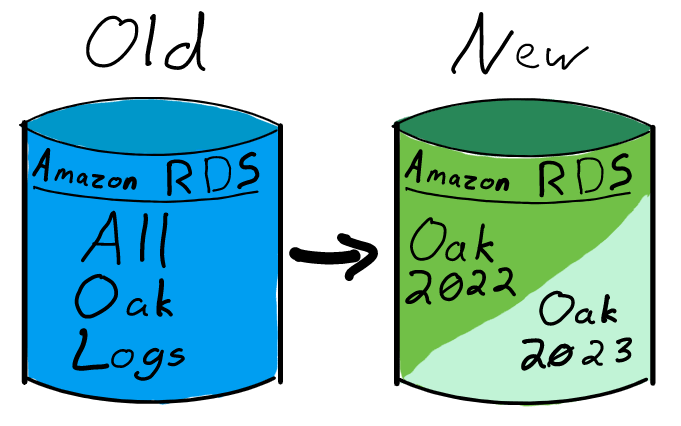
However, if heavy maintenance is required on any part of the underlying database, it would affect every log shard contained within. In particular, we know from using MariaDB with InnoDB inside the Let’s Encrypt CA infrastructure that truncating and deleting a multi-terabyte table causes performance issues for the whole database while the operation runs. Inside the CA infrastructure we mitigate that performance issue by deleting table data only on database replicas; this is more complicated in a more hands-off managed hosting environment like RDS.
Since we wish to clear out old data regularly as a matter of data hygiene, and the performance requirements for a CT log are strict, this option wasn’t feasible.
Distinct RDS Instance per Log Shard
While it increases the number of managed system components, it is much cleaner to give each temporal log shard its own database instance. Like the Distinct Schema per Log Shard model, we now run Trillian CTFE, Log Server, and Log Signer instances for each temporal log shard. However, each log shard gets its own RDS instance for the active life of the log 5. At log shutdown, the RDS instance is simply deprovisioned.
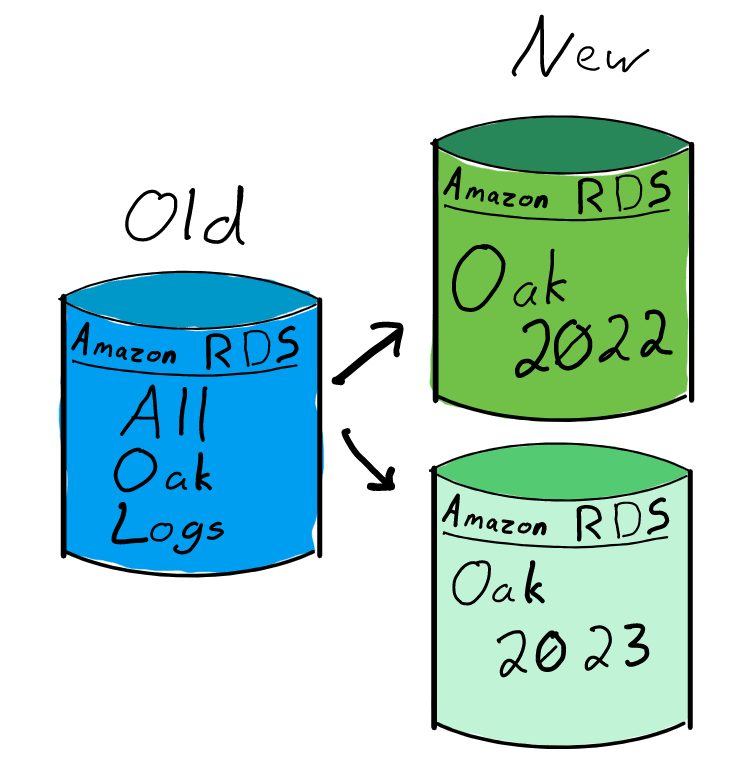
With the original specifications for the Oak log, this would require allocating a significant amount of data I/O resources. However, years of experience running the Testflume log showed that Trillian in AWS did not require the highest possible disk performance.
Tuning IOPS
We launched Oak using the highest performance AWS Elastic Block Storage available at the time: Provisioned IOPS SSDs (type io1). Because of the strict performance requirements on CT logs, we worried that without the best possible performance for disk I/O that latency issues might crop up that could lead to disqualification. As we called out in our blog post How Let’s Encrypt Runs CT Logs, we hoped that we could use a simpler storage type in the future.
To test that, we used General Purpose SSD storage type (type gp2) for our testing CT log, Testflume, and obtained nominal results over the lifespan of the log. In practice higher performance was unnecessary because Trillian makes good use of database indices. Downloading the whole log tree from the first leaf entry is the most significant demand of disk I/O, and that manner of operation is easily managed via rate limits at the load balancer layer.
Our 2022 and 2023 Oak shards now use type gp2 storage and are performing well.
Synergistically, the earlier change to run a distinct RDS instance for each temporal log shard has also further reduced Trillian’s I/O load: A larger percentage of the trimmed-down data fits in MariaDB’s in-memory buffer pool.
More Future Improvements
It’s clear that CT logs will continue to accelerate their rate of growth. Eventually, if we remain on this architecture, even a single year’s CT log will exceed the 16 TB table size limit. In advance of that, we’ll have to take further actions. Some of those might be:
-
Change our temporal log sharding strategy to shorter-than-year intervals, perhaps every 3 or 6 months.
-
Reduce the absolute storage requirements for Trillian’s MySQL-compatible storage backend by de-duplicating intermediate certificates.
-
Contribute a patch to add table sharding to Trillian’s MySQL-compatible storage backend.
-
Change storage backends entirely, perhaps to a sharding-aware middleware, or another more horizontally-scalable open-source system.
We’ve also uprooted our current Testflume CT log and brought online a replacement which we’ve named Sapling. As before, this test-only log will evaluate more aggressive configurations that might bear fruit in the future.
As Always, Scaling Data Is The Hard Part
Though the performance requirements for CT logs are strict, the bulk of the scalability difficulty has to do with the large amount of data and the high and ever-increasing rate of growth; this is the way of relational databases. Horizontal scaling continues to be the solution, and is straightforward to apply to the open source Trillian and MariaDB stack.
Supporting Let’s Encrypt
As a nonprofit project, 100% of our funding comes from contributions from our community of users and supporters. We depend on their support in order to provide our services for the public benefit. If your
company or organization would like to sponsor Let’s Encrypt please email us at [email protected]. If you can support us with a donation, we ask that you make an individual contribution.
-
Chrome and Safari check that certificates include evidence that certificates were submitted to CT logs. If a certificate is lacking that evidence, it won’t be trusted. https://certificate.transparency.dev/useragents/ ↩︎
-
As of publication, these organizations have logs Google Chrome considers qualified for Certificate Authorities to embed their signed timestamps: Cloudflare, DigiCert, Google, Let’s Encrypt, and Sectigo. https://ct.cloudflare.com/logs ↩︎
-
DigiCert’s Yeti CT log deployment at AWS uses a custom Apache Cassandra backend; Oak is the only production log using the Trillian project’s MySQL-compatible backend. SSLMate maintains a list of known log software at https://sslmate.com/labs/ct_ecosystem/ecosystem.html ↩︎
-
In the recent past, a cosmic ray event led to the disqualification of a CT log. Andrew Ayer has a good discussion of this in his post “How Certificate Transparency Logs Fail and Why It’s OK” https://www.agwa.name/blog/post/how_ct_logs_fail, which references the discovery on the ct-policy list https://groups.google.com/a/chromium.org/g/ct-policy/c/PCkKU357M2Q/m/xbxgEXWbAQAJ\ ↩︎
-
Logs remain online for a period after they stop accepting new entries to give a grace period for mirrors and archive activity. ↩︎
Nurturing Continued Growth of Our Oak CT Log
Post Syndicated from Let's Encrypt original https://letsencrypt.org/2022/05/19/nurturing-ct-log-growth.html
Let’s Encrypt has been running a Certificate Transparency (CT) log since 2019 as part of our commitment to keeping the Web PKI ecosystem healthy. CT logs have become important infrastructure for an encrypted Web 1, but have a well-deserved reputation for being difficult to operate at high levels of trust: Only 6 organizations run logs that are currently considered to be “qualified.” 2
Our Oak log is the only qualified CT log that runs on an entirely open source stack 3. In the interest of lowering the barrier for other organizations to join the CT ecosystem, we want to cover a few recent changes to Oak that might be helpful to anyone else planning to launch a log based on Google’s Trillian backed by MariaDB:
-
The disk I/O workload of Trillian atop MariaDB is easily mediated by front-end rate limits, and
-
It’s worth the complexity to split each new annual CT log into its own Trillian/MariaDB stack.
This post will update some of the information from the previous post How Let’s Encrypt Runs CT Logs.
Growing Oak While Staying Open Source
Oak runs on a free and open source stack: Google’s Trillian data store, backed by MariaDB, running at Amazon Web Services (AWS) via Amazon’s Relational Database Service (RDS). To our knowledge, Oak is the only trusted CT log without closed-source components 3.

Other operators of Trillian have opted to use different databases which segment data differently, but the provided MySQL-compatible datastore has successfully kept up with Let’s Encrypt’s CT log volume (currently above 400 GB per month). The story for scaling Oak atop MariaDB is quite typical for any relational database, though the performance requirements are stringent.
Keeping Oak Qualified
The policies that Certificate Transparency Log operators follow require there to be no significant downtime, in addition to the more absolute and difficult requirement that the logs themselves make no mistakes: Given the append-only nature of Certificate Transparency, seemingly minor data corruption prompts permanent disqualification of the log 4. To minimize the impacts of corruption, as well as for scalability reasons, it’s become normal for CT logs to distribute the certificates they contain in different, smaller individual CT logs, called shards.
Splitting Many Years Of Data Among Many Trees
The Let’s Encrypt Oak CT log is actually made up of many individual CT log shards each named after a period of time: Oak 2020 contains certificates which expired in 2020; Oak 2022 contains certificates which expire in 2022. For ease of reference, we refer to these as “temporal log shards,” though in truth each is an individual CT log sharing the Oak family name.
It is straightforward to configure a single Trillian installation to support multiple CT log shards. Each log shard is allocated storage within the backing database, and the Trillian Log Server can then service requests for all configured logs.
The Trillian database schema is quite compact and easy to understand:
-
Each configured log gets a Tree ID, with metadata in several tables.
-
All log entries – certificates in our case – get a row in LeafData.
-
Entries that haven’t been sequenced yet get a row in the table Unsequenced, which is normally kept empty by the Trillian Log Signer service.
-
Once sequenced, entries are removed from the Unsequenced table and added as a row in SequencedLeafData.

In a nutshell: No matter how many different certificate transparency trees and subtrees you set up for a given copy of Trillian, all of them will store the lion’s share of their data, particularly the DER-encoded certificates themselves, interwoven into the one LeafData table. Since Trillian Log Server can only be configured with a single MySQL connection URI, limiting it to a single database, that single table can get quite big.
For Oak, the database currently grows at a rate of about 400 GB per month; that rate is ever-increasing as the use of TLS grows and more Certificate Authorities submit their certificates to our logs.
Amazon RDS Size Limitations
In March 2021 we discovered that Amazon RDS has a 16TB limit per tablespace when RDS is configured to use one file-per-table, as we were doing for all of our CT log shards. Luckily, we reached this limit first in our testing environment, the Testflume log.
Part of Testflume’s purpose was to grow ahead of the production logs in total size, as well as test growth with more aggressive configuration options than the production Oak log had, and in these ways it was highly successful.
Revisiting Database Design
In our blog post, How Let’s Encrypt Runs CT Logs, we wrote that each year we planned “to freeze the previous year’s shard and move it to a less expensive serving infrastructure, reclaiming its storage for our live shards.” However, that is not practical while continuing to serve traffic from the same database instance. Deleting terabytes of rows from an InnoDB table that is in-use is not feasible. Trillian’s MySQL-compatible storage backend agrees: as implemented, Trillian’s built-in Tree Deletion mechanism marks a tree as “soft deleted," and leaves the removal of data from the LeafData table (and others) as an exercise for the administrator.
Since Trillian’s MySQL-compatible backend does not support splitting the LeafData among multiple tables by itself, and since deleting stale data from those tables yields slow performance across the whole database server, to continue to scale the Oak CT log we have to instead prune out the prior seasons’ data another way.
Single RDS Instance with Distinct Schema per Log Shard
We considered adding new database schemas to our existing MariaDB-backed Amazon RDS instance. In this design, we would run a Trillian CT Front-End (CTFE) instance per temporal log shard, each pointing to individual Trillian Log Server and Log Signer instances, which themselves point to a specific temporally-identified database schema name and tablespace. This is cost-effective, and it gives us ample room to avoid the 16 TB limit.

However, if heavy maintenance is required on any part of the underlying database, it would affect every log shard contained within. In particular, we know from using MariaDB with InnoDB inside the Let’s Encrypt CA infrastructure that truncating and deleting a multi-terabyte table causes performance issues for the whole database while the operation runs. Inside the CA infrastructure we mitigate that performance issue by deleting table data only on database replicas; this is more complicated in a more hands-off managed hosting environment like RDS.
Since we wish to clear out old data regularly as a matter of data hygiene, and the performance requirements for a CT log are strict, this option wasn’t feasible.
Distinct RDS Instance per Log Shard
While it increases the number of managed system components, it is much cleaner to give each temporal log shard its own database instance. Like the Distinct Schema per Log Shard model, we now run Trillian CTFE, Log Server, and Log Signer instances for each temporal log shard. However, each log shard gets its own RDS instance for the active life of the log 5. At log shutdown, the RDS instance is simply deprovisioned.

With the original specifications for the Oak log, this would require allocating a significant amount of data I/O resources. However, years of experience running the Testflume log showed that Trillian in AWS did not require the highest possible disk performance.
Tuning IOPS
We launched Oak using the highest performance AWS Elastic Block Storage available at the time: Provisioned IOPS SSDs (type io1). Because of the strict performance requirements on CT logs, we worried that without the best possible performance for disk I/O that latency issues might crop up that could lead to disqualification. As we called out in our blog post How Let’s Encrypt Runs CT Logs, we hoped that we could use a simpler storage type in the future.
To test that, we used General Purpose SSD storage type (type gp2) for our testing CT log, Testflume, and obtained nominal results over the lifespan of the log. In practice higher performance was unnecessary because Trillian makes good use of database indices. Downloading the whole log tree from the first leaf entry is the most significant demand of disk I/O, and that manner of operation is easily managed via rate limits at the load balancer layer.
Our 2022 and 2023 Oak shards now use type gp2 storage and are performing well.
Synergistically, the earlier change to run a distinct RDS instance for each temporal log shard has also further reduced Trillian’s I/O load: A larger percentage of the trimmed-down data fits in MariaDB’s in-memory buffer pool.
More Future Improvements
It’s clear that CT logs will continue to accelerate their rate of growth. Eventually, if we remain on this architecture, even a single year’s CT log will exceed the 16 TB table size limit. In advance of that, we’ll have to take further actions. Some of those might be:
-
Change our temporal log sharding strategy to shorter-than-year intervals, perhaps every 3 or 6 months.
-
Reduce the absolute storage requirements for Trillian’s MySQL-compatible storage backend by de-duplicating intermediate certificates.
-
Contribute a patch to add table sharding to Trillian’s MySQL-compatible storage backend.
-
Change storage backends entirely, perhaps to a sharding-aware middleware, or another more horizontally-scalable open-source system.
We’ve also uprooted our current Testflume CT log and brought online a replacement which we’ve named Sapling. As before, this test-only log will evaluate more aggressive configurations that might bear fruit in the future.
As Always, Scaling Data Is The Hard Part
Though the performance requirements for CT logs are strict, the bulk of the scalability difficulty has to do with the large amount of data and the high and ever-increasing rate of growth; this is the way of relational databases. Horizontal scaling continues to be the solution, and is straightforward to apply to the open source Trillian and MariaDB stack.
Supporting Let’s Encrypt
As a nonprofit project, 100% of our funding comes from contributions from our community of users and supporters. We depend on their support in order to provide our services for the public benefit. If your
company or organization would like to sponsor Let’s Encrypt please email us at [email protected]. If you can support us with a donation, we ask that you make an individual contribution.
-
Chrome and Safari check that certificates include evidence that certificates were submitted to CT logs. If a certificate is lacking that evidence, it won’t be trusted. https://certificate.transparency.dev/useragents/ ↩︎
-
As of publication, these organizations have logs Google Chrome considers qualified for Certificate Authorities to embed their signed timestamps: Cloudflare, DigiCert, Google, Let’s Encrypt, Sectigo, and TrustAsia. https://ct.cloudflare.com/logs and https://twitter.com/__agwa/status/1527407151660122114 ↩︎
-
DigiCert’s Yeti CT log deployment at AWS uses a custom Apache Cassandra backend; Oak is the only production log using the Trillian project’s MySQL-compatible backend. SSLMate maintains a list of known log software at https://sslmate.com/labs/ct_ecosystem/ecosystem.html ↩︎
-
In the recent past, a cosmic ray event led to the disqualification of a CT log. Andrew Ayer has a good discussion of this in his post “How Certificate Transparency Logs Fail and Why It’s OK” https://www.agwa.name/blog/post/how_ct_logs_fail, which references the discovery on the ct-policy list https://groups.google.com/a/chromium.org/g/ct-policy/c/PCkKU357M2Q/m/xbxgEXWbAQAJ\ ↩︎
-
Logs remain online for a period after they stop accepting new entries to give a grace period for mirrors and archive activity. ↩︎
Analyze Amazon Ion datasets using Amazon Athena
Post Syndicated from Pathik Shah original https://aws.amazon.com/blogs/big-data/analyze-amazon-ion-datasets-using-amazon-athena/
Amazon Athena is an interactive query service that makes it easy to analyze data in Amazon Simple Storage Service (Amazon S3) using standard SQL. Athena is serverless, so there is no infrastructure to manage, and you pay only for the queries that you run.
Amazon Ion is a richly typed, self-describing, hierarchical data serialization format offering interchangeable binary and text representations. The text format extends JSON (meaning all JSON files are valid Ion files), and is easy to read and author, supporting rapid prototyping. The binary representation is efficient to store, transmit, and skip-scan parse. The rich type system provides unambiguous semantics for long-term preservation of data that can survive multiple generations of software evolution.
Athena now supports querying and writing data in Ion format. The Ion format is currently used by internal Amazon teams, by external services such as Amazon Quantum Ledger Database (Amazon QLDB) and Amazon DynamoDB (which can be exported into Ion), and in the open-source SQL query language PartiQL.
In this post, we discuss use cases and the unique features Ion offers, followed by examples of querying Ion with Athena. For demonstration purposes, we use the transformed version of the City Lots San Francisco dataset.
Features of Ion
In this section, we discuss some of the unique features that Ion offers:
- Type system
- Dual format
- Efficiency gains
- Skip scanning
Type system
Ion extends JSON, adding support for more precise data types to improve interpretability, simplify processing, and avoid rounding errors. These high precision numeric types are essential for financial services, where fractions of a cent on every transaction add up. Data types that are added are arbitrary-size integers, binary floating-point numbers, infinite-precision decimals, timestamps, CLOBS, and BLOBS.
Dual format
Users can be presented with a familiar text-based representation while benefiting from the performance efficiencies of a binary format. The interoperability between the two formats enables you to rapidly discover, digest, and interpret data in a familiar JSON-like representation, while underlying applications benefit from a reduction in storage, memory, network bandwidth, and latency from the binary format. This means you can write plain text queries that run against both text-based and binary-based Ion. You can rewrite parts of your data in text-based Ion when you need human readable data during development and switch to binary in production.
When debugging a process, the ability for systems engineers to locate data and understand it as quickly as possible is vital. Ion provides mechanisms to move between binary and a text-based representation, optimizing for both the human and the machine. Athena supports querying and writing data in both of these Ion formats. The following is an example Ion text document taken from the transformed version of the citylots dataset:
Efficiency gains
Binary-encoded Ion reduces file size by moving repeated values, such as field names, into a symbol table. Symbol tables reduce CPU and read latency by limiting the validation of character encoding to the single instance of the value in the symbol table.
For example, a company that operates at Amazon’s scale can produce large volumes of application logs. When compressing Ion and JSON logs, we noticed approximately 35% less CPU time to compress the log, which produced an average of roughly 26% smaller files. Log files are critical when needed but costly to retain, so the reduction in file sizes combined with the read performance gains from symbol tables helps when handling these logs. The following is an example of file size reduction with the citylots JSON dataset when converted to Ion binary with GZIP and ZSTD compression:
Skip-scanning
In a textual format, every byte must be read and interpreted, but because Ion’s binary format is a TLV (type-length-value) encoding, an application may skip over elements that aren’t needed. This reduces query and application processing costs correlated with the proportion of unexamined fields.
For example, forensic analysis of application log data involves reading large volumes of data where only a fraction of the data is needed for diagnosis. In these scenarios, skip-scanning allows the binary Ion reader to move past irrelevant fields without the cost of reading the element stored within a field. This results in users experiencing lower resource usage and quicker response times.
Query Ion datasets using Athena
Athena now supports querying and creating Ion-formatted datasets via an Ion-specific SerDe, which in conjunction with IonInputFormat and IonOutputFormat allows you to read and write valid Ion data. Deserialization allows you to run SELECT queries on the Ion data so that it can be queried to gain insights. Serialization through CTAS or INSERT INTO queries allows you to copy datasets from existing tables’ values or generate new data in the Ion format.
The interchangeable nature of Ion text and Ion binary means that Athena can read datasets that contain both types of files. Because Ion is a superset of JSON, a table using the Ion SerDe can also include JSON files. Unlike the JSON SerDe, where every new line character indicates a new row, the Ion SerDe uses a combination of closing brackets and new line characters to determine new rows. This means that if each JSON record in your source documents isn’t on a single line, these files can now be read in Athena via the Ion SerDe.
Create external tables
Athena supports querying Ion-based datasets by defining AWS Glue tables with the user-defined metadata. Let’s start with an example of creating an external table for a dataset stored in Ion text. The following is a sample row from the citylots dataset:
To create an external table that has its data stored in Ion, you have two syntactic options.
First, you can specify STORED AS ION. This is a more concise method, and is best used for simple cases, when no additional properties are required. See the following code:
Alternatively, you can explicitly specify the Ion classpaths in ROW FORMAT SERDE, INPUTFORMAT, and OUTPUTFORMAT. Unlike the first method, you can specify a SERDEPROPERTIES clause here. In our example DDL, we added a SerDe property that allows values that are outside of the Hive data type ranges to overflow rather than fail the query:
Athena converts STORED AS ION into the explicit classpaths, so both tables look similar in the metastore. If we look in AWS Glue, we see both tables we just created have the same input format, output format, and SerDe serialization library.
Now that our table is created, we can run standard SELECT queries on the city_lots_ion table. Let’s run a query that specifies the block_num from our example row of Ion data to verify that we can read from the table:
The following screenshot shows our results.
Use path extraction to read from specific fields
Athena supports further customization of how data is interpreted via SerDe properties. To specify these, you can add a WITH SERDEPROPERTIES clause, which is a subfield of the ROW FORMAT SERDE field.
In some situations, we may only care about some parts of the information. Let’s suppose we don’t want any of the geometry info from the citylots dataset, and only need a few of the fields in properties. One solution is to specify a search path using the path extractor SerDe property:
Path extractors are search paths that Athena uses to map the table columns to locations in the individual document. Full information on what can be done with path extractors is available on GitHub, but for our example, we focus on creating simple paths that use the names of each field as an index. In this case, the search path takes the form of a space-delimited set of indexes (and wraps it with parentheses) that indicate the location of each desired piece of information. We map the search paths to table columns by using the path extractor property.
By default, Athena builds path extractors dynamically based on column names unless overridden. This means that when we run our SELECT query on our city_lots_ion1 table, Athena builds the following search paths:
Assuming we only care about the block and lot information from the properties struct, and the geometry type from the geometry struct, we can build search paths that map the desired fields from the row of data to table columns. First let’s build the search paths:
Now let’s map these search paths to table columns using the path extractor SerDe property. Because the search paths specify where to look for data, we are able to flatten and rename our datasets to better serve our purpose. For this example, let’s rename the mapblklot field to map_block_lot, blklot to block_lot, and the geometry type to shape:
Let’s put all of this together and create the city_blocks table:
Now we can run a select query on the city_blocks table, and see the results:
Utilizing search paths in this way enables skip-scan parsing when reading from Ion binary files, which allows Athena to skip over the unneeded fields and reduces the overall time it takes to run the query.
Use CTAS and UNLOAD for data transformation
Athena supports CREATE TABLE AS SELECT (CTAS), which creates a new table in Athena from the results of a SELECT statement from another query. Athena also supports UNLOAD, which writes query results to Amazon S3 from a SELECT statement to the specified data format.
Both CTAS and UNLOAD have a property to specify a format and a compression type. This allows you to easily convert Ion datasets to other data formats, such as Parquet or ORC, and vice versa, without needing to set up a complex extract, transform, and load (ETL) job. This is beneficial for situations when you want to transform your data, or know you will run repeated queries on a subset of your data and want to use some of the benefits inherent to columnar formats. Combining it with path extractors is especially helpful, because we’re only storing the data that we need in the new format.
Let’s use CTAS to convert our city_blocks table from Ion to Parquet, and compress it via GZIP. Because we have path extractors set up for the city_blocks table, we only need to convert a small portion of the original dataset:
We can now run queries against the city_block_parquet_gzip table, and should see the same result. To test this out, let’s run the same SELECT query we ran before on the Parquet table:
When converting tables from another format to Ion, Athena supports the following compression codecs: ZSTD, BZIP2, GZIP, SNAPPY, and NONE. In addition to adding Ion as a new format for CTAS, we added the ion_encoding property, which allows you to choose whether the output files are created in Ion text or Ion binary. This allows for serialization of data from other formats back into Ion.
Let’s convert the original city_lots JSON file back to Ion, but this time we specify that we want to use ZSTD compression and a binary encoding.
The JSON file can be found at following location: s3://aws-bigdata-blog/artifacts/athena-ion-blog/city_lots_json/
Because Ion is a superset of JSON, we can use the Ion SerDe to read this file:
Now let’s copy this table into our desired Ion binary form:
Finally, let’s run our verification SELECT statement to verify everything was created properly:
Use UNLOAD to store Ion data in Amazon S3
Sometimes we just want to reformat the data and don’t need to store the additional metadata to query the table. In this case, we can use UNLOAD, which stores the results of the query in the specified format in an S3 bucket.
Let’s test it out, using UNLOAD to convert the drivers_names table from Ion to ORC, compress it via ZLIB, and store it to an S3 bucket:
When you check in Amazon S3, you can find a new file in the ORC format.
Conclusion
This post talked about the new feature in Athena that allows you to query and create Ion datasets using standard SQL. We discussed use cases and unique features of the Ion format like type system, dual formats (Ion text and Ion binary), efficiency gains, and skip-scanning. You can get started with querying an Ion dataset stored in Amazon S3 by simply creating a table in Athena, and also converting existing datasets to Ion format and vice versa using CTAS and UNLOAD statements.
To learn more about querying Ion using Athena, refer to Amazon Ion Hive SerDe.
References
- Name of Dataset: City Lots San Francisco in .json
- Licenses and Notes: OG dataset under PDDL 1.0; Github .json version under MIT style license
- Link(s) to Dataset(s) (note – original dataset is NLA from DataSF)
- Location of transformed version
About the Authors
 Pathik Shah is a Sr. Big Data Architect on Amazon Athena. He joined AWS in 2015 and has been focusing in the big data analytics space since then, helping customers build scalable and robust solutions using AWS analytics services.
Pathik Shah is a Sr. Big Data Architect on Amazon Athena. He joined AWS in 2015 and has been focusing in the big data analytics space since then, helping customers build scalable and robust solutions using AWS analytics services.
 Jacob Stein works on the Amazon Athena team as a Software Development Engineer. He led the project to add support for Ion in Athena. He loves working on technical problems unique to internet scale data, and is passionate about developing scalable solutions for distributed systems.
Jacob Stein works on the Amazon Athena team as a Software Development Engineer. He led the project to add support for Ion in Athena. He loves working on technical problems unique to internet scale data, and is passionate about developing scalable solutions for distributed systems.
 Giovanni Matteo Fumarola is the Engineering Manager of the Athena Data Lake and Storage team. He is an Apache Hadoop Committer and PMC member. He has been focusing in the big data analytics space since 2013.
Giovanni Matteo Fumarola is the Engineering Manager of the Athena Data Lake and Storage team. He is an Apache Hadoop Committer and PMC member. He has been focusing in the big data analytics space since 2013.
Dissecting Cheap Projectors
Post Syndicated from The Hook Up original https://www.youtube.com/watch?v=clefLJiDnQM
